- Dog Health & Care
- Dog Nutrition
- Dog Training
- Vet Approved

How Much Does an Emergency Vet Cost for Dogs? 2024 Price Update
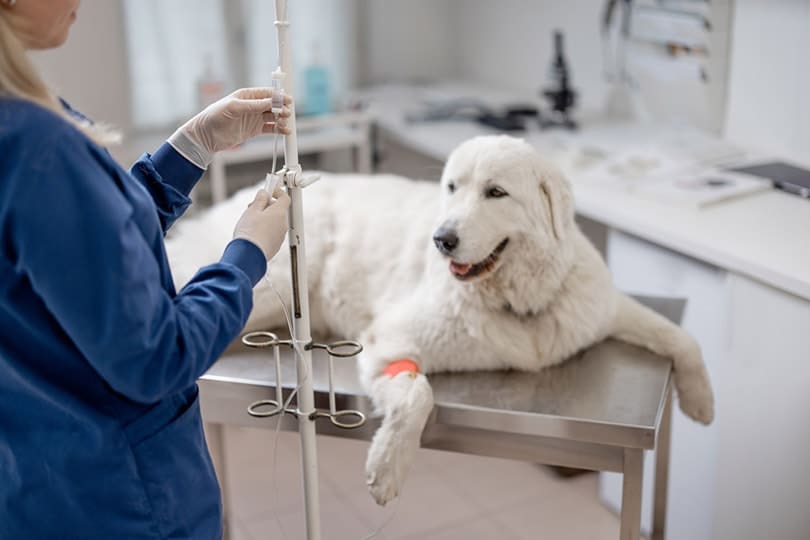
Image Credit: RossHelen, Shutterstock
Last Updated on April 12, 2024 by Dogster Team
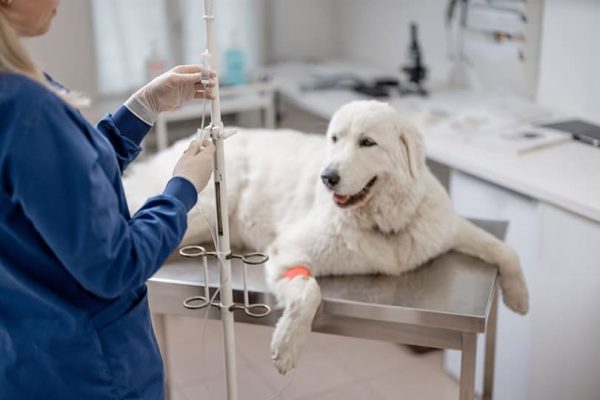
VET APPROVED
REVIEWED & FACT-CHECKED BY
Dr. Tabitha Henson
DVM (Veterinarian)
The information is current and up-to-date in accordance with the latest veterinarian research.
Your dog may become sick or injured when your vet clinic is closed and when this happens, you will have to rush your dog to an emergency vet clinic.
Beyond the worry and fear of this kind of visit, sometimes the price is a factor. How much a visit to an emergency vet clinic costs depends on several factors. But as a general overview, the average cost of an emergency vet could be anywhere from $250 to as much as $8,000. Here, we get into what these are and provide you with a range of possible prices that you can expect to pay under those circumstances.

- The Importance of Your Dog’s Health
We all want our pets to be in good health for their entire lives, but accidents and health conditions can happen unexpectedly. Several conditions can lead you to bring your dog to an emergency vet clinic, including:
- Injuries and trauma (possible broken bones, deep gashes, burns, etc.)
- Gastroenteritis (diarrhea, vomiting)
- Neurological disorders (seizures)
- Weakness and collapse
- Difficulties breathing
- The ingestion of toxins
- Extreme lethargy
- Significant bleeding
- Straining to urinate or blood in urine
Of course, this list is not exhaustive, and there are times when you will need to figure out when it’s a real emergency . If you’re unsure if your dog requires a vet’s help, call ahead to the emergency clinic, and the staff can help you decide if it’s necessary to bring your dog in. You also have the advantage of giving them advance notice that you’re coming.
- How Much Does an Emergency Vet Visit Cost?
How much a visit to an emergency vet will cost depends on numerous details, including the time, day, location, size of your dog, the clinic itself, and what condition or injury your dog has.
The vet will typically start with a thorough physical exam of your dog to determine if there are any other underlying issues beyond what you brought them in for.
This could be followed by the vet recommending treatments and further diagnostic tests, which might include running bloodwork or a urinalysis, X-rays, ultrasounds, surgery, etc. In most cases, your dog might only need medication, but in some circumstances, a stay at the clinic and extensive workup might be in order.
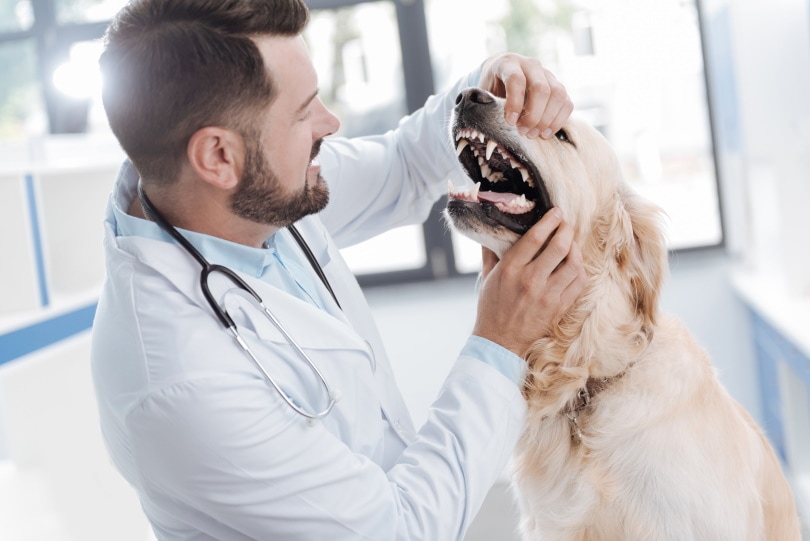
The average cost of an emergency vet could be anywhere from $250 to as much as $8,000.
The following chart should help break down these costs.
Remember that these costs are just general estimates and averages. With so many varying factors, it’s difficult to precisely pinpoint what you’ll end up paying.
However, even the estimated prices are impressive. If you have a desire to save money during an emergency for your dog, it doesn’t make you a bad owner. It shows that you want to anticipate such situations and save your nerves.
Being a pet parent is not only about fun games and cuddling with your dog. It is also about being responsible and making decisions about what’s best for your pooch and you.
Therefore, the sooner you start thinking about pet alternative insurance and how to act in emergencies, the less stressful such a case will be for you.

- Additional Costs to Anticipate
Beyond the visit, treatment, and any diagnostic tests, there are a few additional expenses that you might need to pay.
Any medications that your vet prescribes for your dog—oral medications or even topical treatments—will need to be paid for separately.
There’s the possibility of equipment, particularly after surgery, such as e-collars and vests, so your pup doesn’t chew and lick the wound.
You’ll potentially need to bring your dog back to the clinic for follow-up appointments, particularly if your dog was physically injured. There’s also the chance of you needing other specialty items, depending on your dog’s condition, such as prescription dog food.
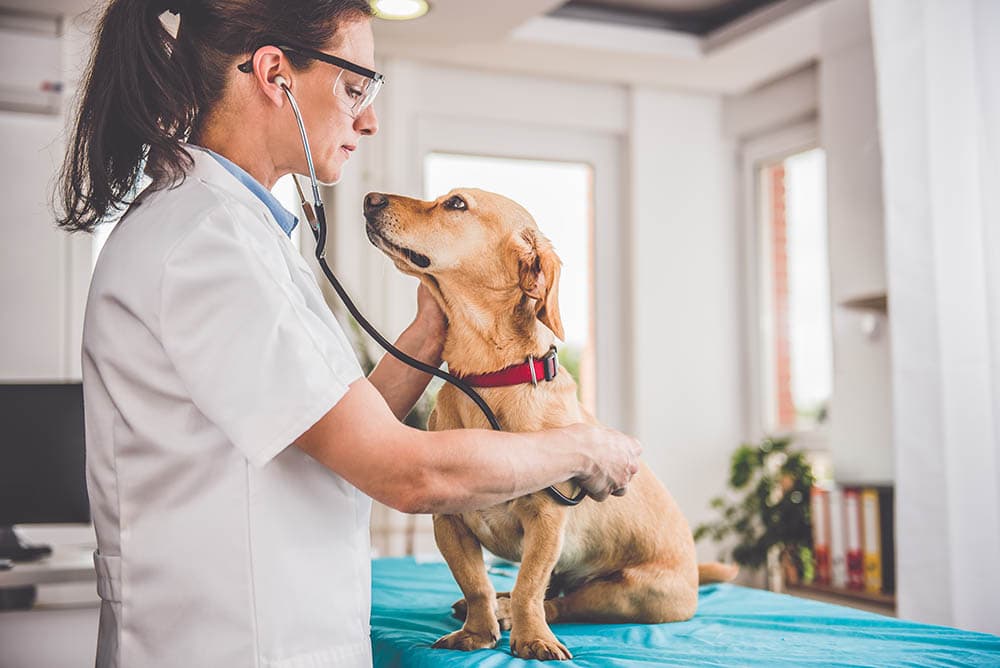
- How Can I Afford an Emergency?
There are a few steps that you can take to help you afford an emergency situation.
- Talk to the Vet
First of all, let the vet know about your finances. This way, they can find less expensive alternatives that where possible, won’t compromise your dog’s health. This can also include asking for generic rather than brand-name prescriptions and filling them at your own pharmacy.
- Specialized Credit Cards
There are specialized credit cards that you can consider. It enables you to pay for your dog’s and your own medical needs. You’ll just need to make sure the emergency clinic and your regular vet will accept the card.

- Plan a Budget
Consider setting up a savings account meant for any dog medical emergencies. You can create a new account and make a point of adding money every week or month.
If you put about $100 in the account every month when your dog is a puppy, by the time, they’re 2 years old, you might have saved up around $2,000. Only use this money for actual emergencies, rather than routine visits. This way, you’re saving money that could end up saving your dog’s life.
- Virtual Vet
If your dog isn’t exhibiting emergency symptoms but you feel as though you can’t wait for an appointment in a few days, you can try speaking to a virtual veterinarian. This could be done by phone or through video.
For example, if you suspect that your dog has an ear infection, this isn’t exactly an emergency (at least not in the early stages), and a virtual vet can prescribe you the appropriate medication. This can help save you money.
There’s also pet insurance.

- Does Pet Insurance Cover Emergency Clinic Visits?
It depends on the insurance company. Some will cover emergencies but not if your dog has a pre-existing condition (although this is usually if your dog already had a health condition before you started coverage).
Typically, you pay anywhere from $10 to $100, but the average tends to be $30 to $50 every month. Some policies might cover a large chunk of the bills, up to 90% for many, and they all cover unexpected costs (except for those pre-existing conditions). In most cases, you will pay the bill yourself and then send the bill and vet records to the insurance company, and they will reimburse you, so you’ll still need to have the money initially for the vet bill.
Just be sure to read everything and figure out which company and which plan will work best for you and your dog. How much you pay every month will also depend on the size, age, breed, and sex of your dog.
- See Also: What Are the Vet Costs for Dog Eye Infection & Eye Surgery?

- How Can You Avoid Emergency Vet Visits?
It will help if you take your dog to your regular vet for wellness checkups annually. If you’re consistent with these visits, your vet can sometimes catch an encroaching health condition before it becomes an emergency. Also, some insurance companies will cover part of these annual visits.
You should also always plan ahead for any potential emergencies. If you’re unable to make it home because of bad weather (blizzards, icy roads, etc.), ensure that a trusted neighbor, family member, or friend has a key to your place so they can take care of your dog in your absence. If you lose power, take your dog with you if you go to a hotel.
However, it can sometimes prove difficult to prevent all emergencies for pets. Accidents happen — you can’t keep an eye on your dog every minute, and they can be fast! Plus, health conditions can occur even in the healthiest of animals.
As long as you feed your dog high-quality food, ensure that they have constant access to clean and fresh water, and visit the vet once a year, you’re taking good care of your pup. You should also give them plenty of love, exercise, and playtime.
While paying a chunk of money every month might not necessarily fit into your budget, it’s probably worth it in the long run. This way, if something disastrous does happen to your pup, you won’t be forced to decide between treatment that you can’t afford and keeping your dog for a few more years.
So many aspects of these scenarios do depend on your dog’s situation, so spend the time looking at the best pet insurance companies and trying out the free quotes. It just might be worth it.
Related dog reads:
- What to Give a Dog for an Upset Stomach — 10 Great Options
- Braces for Dogs — Effectiveness and Costs
- My Dog’s Stomach Is Hard, What Should I Do?
- https://emergencyvetsusa.com/average-cost-of-emergency-vet-visits/
Featured Image Credit: RossHelen, Shutterstock
About the Author
Kathryn Copeland
Kathryn was a librarian in a previous lifetime and is currently a writer about all things pets. When she was a kid, she hoped to work in a zoo or with wildlife in some way, thanks to her love for animals. Unfortunately, she's not strong in the sciences, so she fills her days with researching and writing about all kinds of animals and spends time playing with her adorable but terribly naughty tabby cat, Bella. Kathryn is hoping to add to her family in the near future – maybe another cat or two and a dog.

Pet Care Insurance Review 2024: Pros, Cons & Verdict

How to Use Guillotine Dog Nail Clippers: Vet-Approved Instructions

Military Dog Hearing Protection: How They Protect Their Ears (Vet Approved)
Get dogster in your inbox.

230 Stereotypical Dog Names: Most Classic & Common Options

Neddy’s Day Spa: A Chihuahua’s Guide to Ear Cleaning & Self-Care

Austin Air HealthMate Review 2024: An Expert’s Breakdown
© pangolia pte. ltd. all rights reserved..

- Find Veterinarians

Average Cost Of Emergency Vet Visits
Taking your pet to an emergency vet is similar to how we go to an ER or urgent care clinic.
Usually you will take your pet to an animal hospital when your regular vet is closed or the health of your pet is beyond what your local vet can handle.
Emergency veterinary clinics are usually open 24/7 and always have a qualified ER veterinarian on staff.
Emergency veterinary clinics are also there to handle crisis situations that your regular veterinarian may not have the capacity to take care of in their specific clinic setting.
For instance, various medical conditions require pets to be hospitalized overnight with care from veterinary nurses, and some general practice veterinary clinics just do not have the capacity to provide that service.
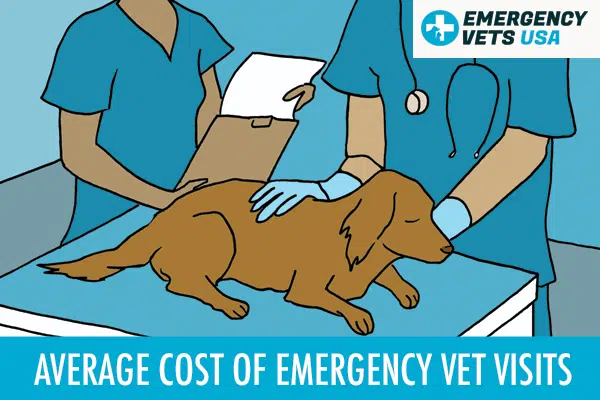
General Costs of Going To An Emergency Vet
Depending on the reason you are having to take your pet to the emergency vet clinic, the costs can vary drastically.
An emergency surgery is going to cost a lot more than an ER visit for a torn toenail.
The cost also may vary based off of the size of your pet, as larger dogs will need more medications and fluids, thus making their ER visit cost more than the cost for a small dog or cat.
The chart below provides a general breakdown of broad categories of diagnostics & treatments your pet may need at an emergency veterinary clinic.
These cost will range depending on where you live in the USA, how many vets are in your area and the time of care.
As you can see the prices will range depending on the type of treatment.
The list above may not be what you pay for services in your area.
The prices are averages based on the type of treatment being offered.
Other costs not mentioned would be, medications, follow up appointments, other office fees.
For example, a dog that was hit by a car will need multiple follow up appointments which will increase the overall cost of their bill.
How To Pay Your Emergency Vet Bill

After your pet is examined and a plan is set forth to determine what diagnostics and/or treatments they need, the veterinary staff will provide you with an estimated bill.
This may vary location to location, but most emergency clinics require that you pay half your estimated bill up front and the remainder when you take your pet home.
When you take your pet home depends on the severity of their condition.
For example, if your dog was hit by a car, they may require multiple surgeries, follow up care, bandage replacement, oxygen, medications, etc.
These costs will add up over time. The emergency vet clinic will require payment for most services up front before you take your dog home.
Having a large estimated bill can be initially overwhelming for sure.
Top Two Ways To Pay For Your Emergency Vet Bill
Pawp – a new way to pay for unexpected vet bills.
For those looking for ways to pay for their emergency vet bill, Pawp is a newer idea that is similar to insurance but is different.
Unlike pet insurance, Pawp covers up to 6 pets in your home and allows you access to $3,000 for emergency medical care.
What attracts people to Pawp is their price of just $24/month for all of the benefits listed above.
They offer virtual care, where you can chat with a licensed veterinarian – this alone can save a bit of money by not having to bring your pet to a local vet every time.
Care Credit – Veterinary Financing
Almost all emergency clinics take “ Care Credit-Veterinary Financing ”, which can help you pay your emergency bill owed to them without having to take it all out of pocket immediately.
Care Credit is essentially a pet healthcare credit card. You can apply for it online even while you are waiting at the clinic.
Once you are approved, Care Credit pays everything up front and you pay Care Credit back over the course of a few months, usually interest free.
This can help ease the burden of having to pay a large bill all at once.
Once approved for Care Credit you can use this new form of payment for all future vet costs.
Don’t Hesitate To Ask For Help With Your Bill
Emergency clinics that are looking out for you and your pet’s best interests.
They can be a great place to get life saving treatment when your regular vet is closed.
When your primary veterinarian opens, they may suggest transferring care to them which may help save in costs.
If you are struggling with paying your vet bill , you can ask for discounts or see if they can help with the costs of some of the procedures.
Depending on the emergency vet, you might be able to get a discount of 30-50% off your bill.
No matter what you will have to pay that bill before leaving, whether you put it on credit card, care credit, Pawp, or have family/friends help.
It might seem like some clinics, especially emergency veterinary clinics are out to take your money.
This is more often not the case and they just want to help you and your pet.
It may be tempting to try to wait things out and avoid taking your pet to an ER clinic, but if you are concerned about your pet’s condition it is always best to have them evaluated.
If you are not sure if it is an emergency , you can always call your nearest emergency clinic and tell them what is going on with your pet.
They can help guide you in the right direction on if you should go ahead and take them in or if it is something that can wait until the next day.
When To Contact An Emergency Vet
Just like an ER for people, our pets have a similar option to get immediate help and that is an Emergency Vet or Animal Hospital.
The cost of going to one of these facilities will be more than if you went to your local veterinarian.
Most general vet practices will have you go to an emergency vet for life threatening illnesses or injuries.
Some veterinarians are not equipped or can handle certain injuries, so if you are in need of immediate help it is always best to contact your veterinarian before bringing your pet to them.
An emergency is an injury or illness that cannot wait to be dealt with, such as:
- Your dog has bloody diarrhea
- Your dog is vomiting black
- Your dog has parvo
- Your dog was hit by a vehicle
- Any major trauma (broken bone, major cuts)
- Your dog is bleeding
- Dog chewed a chicken bone
- Your dog is breathing fast (can’t catch breath)

Leslie Brooks graduated from the University of Tennessee College of Veterinary Medicine in 2012. After graduation she moved to Indianapolis to do an intensive one-year internship at a specialty practice and then began working as a small animal general practitioner. She ran her own house call practice for three years, visiting pets in people’s homes. Currently, she works part time in clinical practice and volunteering her free time to serve pets of the homeless. Read more about us here .
There are 4 comments:
Glad to find this article! We have just experienced a heart breaking loss with our 2.5 year old Pointer. My husband and I were out of town when our dog fell very ill. A family member took him to the Emergency Vet Hospital. He was in complete kidney and liver failure due to a toxin of some sort. We still don’t fully understand. The Vet counseled on the phone and then we spoke with a technician who gave us a breakdown of the cost of treatment with no guarantees that it would save him. It was going to cost several thousand dollars for IV therapy, antibiotics and pain meds with hospitalization. My question is, should pet owners of high risk dogs who tend to eat and drink anything in sight take out Pet Insurance? Does the insurance pay off in case of emergency situations?
Late reply but yes insurance is worth it in emergency cases and especially if your dog eats everything. We have a lab that eats everything and he has had an intestinal blockage and might have one now. He eats socks, twigs, hair bands- you name it he’ll eat it. Insurance also reimburses for regular vet visits too.
Thank you. This was very helpful.
Hi Barbara, thank you! Just keep in mind that the average emergency vet bill will range depending on where you live. Kind of like health insurance or even car insurance. You can’t really quote a price that will work for the entire USA. If your pet ends up in an animal hospital just know that you have options on how to pay that bill.
Leave a Reply Cancel reply
Your email address will not be published. Required fields are marked *
How much does an emergency vet cost? Make sure you're prepared for the cost of care
Emergency vet costs can soon mount up. Find out how much you might need should the worst happen
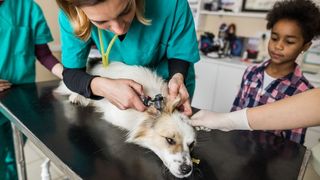
When your pet is in a crisis and you’re rushing to the emergency clinic, you shouldn’t have to dedicate mental time or energy to wondering, “how much does an emergency vet cost?” Instead, your mental energy needs to be focused on your pet, so you can drive safely, provide the veterinary team with the information they need to begin their workup, and make rational decisions as needed.
Many pets experience a veterinary emergency at some time in their life and, unfortunately, emergency veterinary care is often expensive. Even if you have purchased the best pet insurance , you will likely still be responsible for paying veterinary expenses up front until your insurance can reimburse you. Therefore, it’s important to plan ahead.
Emergency veterinarians treat pets when their regular veterinarian’s office is closed (on nights, weekends, or holidays). They treat conditions ranging from mild (such as a hot spot on the skin) to life-threatening trauma (such as a dog that has been hit by a car). On a holiday weekend, an emergency vet may even see everyday cases, like ear infections , that are not life-threatening but should not go days without care. Make sure you talk to your vet about their emergency protocols in advance, so you know who you need to contact and where you should take your pet if an emergency arises or your pet needs care when your veterinarian’s office is closed.
- How to choose pet insurance : A guide to getting the best deal
- Pet insurance advice : Five things to look out for when shopping for the best policy
- How to get cheaper pet insurance
Common pet emergencies
One of the common conditions seen by emergency vets is gastroenteritis, or vomiting and diarrhea. In some cases, the pet may have relatively mild signs; a dog may have had just a few episodes of diarrhea, but its owner wants to know how to help a dog with diarrhoea before the dog’s condition worsens or before the carpet in their home is ruined. In other cases, however, the pet is very ill and may require more aggressive treatment. A dog that is dehydrated after several days of vomiting and diarrhea will need a full medical workup to determine the underlying cause of the illness, plus hospitalization and intravenous (IV) fluids.
Emergency vets also treat trauma and injuries. These cases may range from pad abrasions, to fractures, to severe trauma such as dog fights or being hit by a car.. Many of these cases will need surgery, but some can be stabilized in hospital over the weekend or even sent home with painkillers.
Other potential causes of emergency clinic visits include sudden weakness or collapse, seizures or other neurologic issues, breathing difficulties, and toxin ingestion. These conditions vary significantly in their workup and treatment, but an emergency veterinarian is prepared to handle any of these cases.
- Pet insurance vs prescription plans
- How does pet insurance work?
- Does pet insurance cover vaccines?
The cost of emergency veterinary care
The cost of a veterinary emergency visit varies, depending on a number of factors, including the day, time, location, type of disease or condition, size of your dog, and the experience and equipment of the treating veterinarian.
Your vet will first perform a thorough physical exam on your pet. Don’t be surprised if they seem to avoid or ignore the problem at first – they need to ensure your pet is stable and that nothing else is wrong. In many cases, the veterinarian may listen to your pet’s heart and lungs and check their mucous membrane color before focusing on the part of the body that is related to your pet’s presenting complaint.
Based on the exam findings, the veterinarian will then recommend appropriate diagnostic tests and treatments. Some pets may require only medication, while others will require a comprehensive workup and hospitalization. Obviously, a more involved workup or more invasive treatments will be accompanied with a higher cost. Once your veterinarian has put together a treatment plan for your pet, the costs of these services will be reviewed with you and you can decide whether or not to authorize the recommended services.
According to PetPlan pet insurance, the average cost of a veterinary emergency is $800 to $1,500 . Keep in mind, however, that this is just an average. This estimate is also several years old, and veterinary costs (like other costs) have likely increased since the time this study was performed. Some emergency clinic visits, such as a straightforward case of acute diarrhea, may cost just $200-300 for an exam and medications. If your pet is hit by a car and requires emergency surgery followed by hospitalization, however, your costs may easily climb to $5,000 or more. Therefore, the costs of emergency care are rarely easy to predict.
Preparing for emergencies is an important aspect of responsible pet ownership. Hopefully, your pet will live a happy, healthy life and you will never find yourself dealing with a serious veterinary emergency. If an emergency does occur and you’re prepared, however, you will be in a much better position to authorize high-quality veterinary care. There is nothing we vets dislike more than knowing there’s something that can be done, but the money isn’t there to allow us to do the work.
- Is my dog sick? Ten signs you need to take your dog to the vet
- Ear infections in dogs : Vet's guide to causes and treatment
- Kennel cough in dogs : A vet's guide to symptoms, causes and treatment
- Is pet insurance worth it? A vet’s view

Pet insurance reimburses the cost of emergency care
One popular option for managing the cost of emergency care is pet insurance. In some ways, pet insurance works like human health insurance. You pay a monthly premium in exchange for coverage of a certain percentage of your pet’s medical expenses. You will have a deductible or ‘excess’; expenses will not be eligible for coverage until you exceed this deductible. For some insurance plans this excess is barely more than the cost of the initial consultation, meaning you may find that all further tests and treatments are covered.
Pet insurance usually works by reimbursing you for the cost of the treatment once you’ve submitted the claim. That means that you’ll still have to have access to a sum of money for the vet bill, but only temporarily. If this is likely to be a problem, talk to your vet about whether they accept ‘direct claims’ from any pet insurance providers. This means the cost of the visit will be kept on your account and your vet will claim from the insurer directly, so you aren’t out of pocket. Not all vets and not all insurers will work together on this, so you might have to do some hunting around! Alternatively, you could use a credit card or CareCredit® to fund your pet’s care until you are reimbursed by your insurance company.
What does pet insurance cover?
Pet insurance primarily exists to cover illnesses and injuries. However, there are a few exceptions. Both pre-existing conditions and hereditary conditions are often excluded from pet insurance coverage.
Pre-existing conditions are conditions that were diagnosed before you purchased the insurance policy. For example, if your dog was diagnosed with luxating patellas before you purchased the policy, your insurance policy will likely never cover any treatment related to your pet’s knees. If your pet has had a history of repeated urinary tract infections , your insurance provider may refuse to cover any future urinary issues.
Hereditary conditions are conditions that are genetic, or contained in the DNA. These conditions are inherited through a pet’s parents. Examples of genetic conditions include hip dysplasia, tracheal collapse, and third eyelid prolapse (or “cherry eye”). Many pet insurance companies exclude hereditary conditions from coverage, even if they develop after the policy is purchased.
Many pet insurers also do not cover any costs associated with breeding. So, if you plan to breed your dog and she ends up needing an emergency C-section, most insurers won’t cover this. If she develops mastitis after delivering the puppies, this is also unlikely to be covered by pet insurance.
If you purchase pet insurance, it’s important to read through your policy carefully. Pay careful attention to your financial responsibilities and what is and is not covered by the policy. This can prevent a lot of headaches and frustration! In general, however, pet insurance is a great option to help defray costs associated with emergency veterinary care. We’d also recommend you find out how to get cheaper pet insurance as there are few steps you can take to limit the cost. However, take care shopping around – any symptoms your dog has had with the old insurer can be ‘pre-existing conditions’ with the new insurer!
What if you don’t have pet insurance?
When a pet emergency occurs and you don’t have pet insurance, your options are more limited. Hopefully, you have savings or a credit card available to handle the veterinary bill. If you are a pet owner who has elected not to purchase pet insurance, you should start building a veterinary emergency fund from an early age. Knowing that the average cost of an emergency is over $1,000, you might set a goal to have $2,000 saved by the time your dog reaches 2 years old. Assuming you obtain your puppy when they are four months old, saving just $100 a month would ensure that you are well-equipped to handle an emergency by the time your dog is two years old. If you can afford to save more on a monthly basis, you can likely reach your goal even sooner (or set a higher savings goal). Don’t use this fund for routine veterinary care like vaccines or parasite preventatives; instead, leave this fund alone and use it only in the case of an emergency.
If you do not have available savings or a credit card on hand, many emergency veterinarians in the US offer credit through a company known as CareCredit®. CareCredit® is a credit card designed specifically for medical and veterinary expenses. You can apply online or via telephone and receive a decision within minutes. If you’re approved, there is often a period of interest-free financing available, which may be up to two years. After this interest-free period ends, the interest rate will increase significantly, to a rate that is comparable to a typical credit card.
If you live elsewhere or are unable to get approved for CareCredit®, consider reaching out to friends and family for help. Some clients use GoFundMe® to reach out to friends, family, and social media contacts. Non-profit foundations are also sometimes available to help fund pets’ veterinary care, but working with a non-profit is not always logistically feasible in an emergency situation. Most emergency clinics will require at least an initial deposit before beginning treatment, so you will need to have funds available in a short timeframe.
Remember, talk to your vet about your finances and budget – we can’t help if we don’t know what you can and can’t afford. It may be that we can offer a second-best option that’s significantly cheaper. Your vet may also know where else you can go for financial help.
Hope for the best, prepare for the worst
While we all hope that we will never have to deal with emergency vet costs, the reality is that emergencies happen. There’s a decent chance that you experience at least one or two emergency visits over your pet’s lifetime. Plan ahead and have financial resources in place for emergencies, whether that is a pet insurance plan, a well-funded pet savings account, or accessible credit. Having the ability to pay for emergencies will ensure that your veterinarian can provide your pet with the best possible care.
PetsRadar Newsletter
Get the best advice, tips and top tech for your beloved Pets

Dr. Barnette is a graduate of the University of Florida, where she received both her B.S. in Zoology and her Doctor of Veterinary Medicine (DVM). She has 15 years of clinical experience as a small animal veterinarian, treating dogs, cats, and occasional exotic patients. She now works as a freelance veterinary writer, creating educational content for veterinarians, veterinary team members, and dedicated pet owners. Dr. Barnette lives in southwest Florida with her husband and daughter (plus two cats, a dog, and a rescued dove!) and enjoys kayaking, biking, and hiking. Learn more about Dr. Barnette at www.linkedin.com/in/catherinebarnette .
Why does my cat watch TV? An expert reveals the answer and whether it’s a healthy form of play
What does a cat spraying look like? And why do they do it?
Here’s one surprising thing to consider when it comes to potty training your pup
Most Popular
- 2 Should you let your dog off-leash? Trainer reveals how to know if your pup is ready to fly solo
- 3 Expert reveals how to teach a cat a trick (we can’t believe how simple it is!)
- 4 Try these three trainer-approved tips to get your dog to stop leash-pulling on walks
- 5 Trainer reveals how to get your dog used to ear care in 7 simple steps
- Search Search Please fill out this field.
- Sweepstakes
- Dogs & Puppies
- Dog Health Care
- Dog First Aid & Emergency Care
What Every Pet Parent Needs to Know About Emergency Vet Services
If your pet has an emergency, there's no time to waste.
:max_bytes(150000):strip_icc():format(webp)/Rhyme-Jenna-crop-2000-4ed4f91ae716446ea8b9ed6fed94bb93.jpg)
Dr. Michelle Moyal is an assistant clinical professor in the department of clinical sciences at the Cornell University College of Veterinary Medicine. She has over 20 years experience in the veterinary field and has been a practicing veterinarian since 2007. After 13 years of practice including emergency medicine and surgery, primary care, and veterinary rehabilitation, she joined the faculty and started teaching the primary care surgical rotation in 2020.
:max_bytes(150000):strip_icc():format(webp)/Michelle-Moyal-2020-1e120e110c47417a991dd659ea710a2e.jpg)
What Does an Emergency Vet Service Do?
Types of emergency vet services, how to choose the right service, how much does an emergency vet service cost, where to find an emergency vet service near you.
It's what pet parents dread: Your fur baby is sick or injured and needs to see a veterinarian right away. If this happens during normal business hours, then you can call your regular veterinarian for advice. But what if your pet needs a vet on the weekend or (worse!) in the middle of the night? Fortunately, there are emergency vet services for these situations.
You might already know of some emergency vets near you in case you find yourself in a 911 situation. It's important to have a plan for your pet in case there's an after-hours emergency. It's also helpful to understand what emergency vet hospitals do and the difference between 24/7 emergency vets and after-hours emergency vets. Here's what you need to know.
Emergency veterinary services provide veterinary care to pets after a sudden injury or illness. There are many situations that call for immediate veterinary attention.
"One of the best things about emergency medicine is that there is no such thing as a 'normal day' in the ER—just about anything and everything may present as an emergency," says Adam Lancaster, DVM, DACVECC, who specializes in emergency and critical care at BluePearl Specialty and Emergency Pet Hospital . Lancaster says some common emergencies he treats include:
- Gastrointestinal issues including vomiting , diarrhea , and changes in appetite
- Signs of lower urinary tract disease in cats, such as straining to urinate, urinating frequently, or inability to urinate
- Limping dogs and bite wounds
Emergency vet services see pets in order of urgency, not arrival time. There will be times when you have to wait and other times when your pet will see a vet right away. It's a lot like human emergency departments.
Emergency vet services come in different forms. Some general practices even offer their own urgent care and emergency services via extended hours or on an on-call basis. This is great for continuity of care—your pet will be seen by a vet who knows your pet's history and has access to your records.
After-Hours Vets
Some emergency vets operate on nights and weekends only; they cover the times when many general practice veterinary offices are closed. After-hours vets provide care, then transfer the pet to a general vet or specialist if needed.
Other emergency vet facilities operate 24 hours a day, 365 days a year. They typically provide hospitalization with intensive care and can keep pets for longer periods of time.
Like BluePearl, some 24/7 emergency vet facilities also offer specialty services. This can be helpful if you know your pet has a complex issue that may require specialized care, like a neurological or orthopedic problem.
So, which type of emergency service do you need? Lancaster breaks it down.
"If your pet is sick and you are in need of emergency care, you may want to consider the hours the facility is open (24/7 versus nights and weekends) and whether specialty care is available in addition to ER," he says. "However, in a truly life-threatening emergency where time is of the essence, the closest place is the best place. This way, your pet can be stabilized quickly and, if additional care is required beyond what is available at that facility, they can refer you to another hospital once stable."
There are even cases when you might want to seek out a specialist like Lancaster, who is certified by the American College of Veterinary Emergency & Critical Care (ACVECC). "An ACVECC specialist has received additional training in emergency and critical care, typically having completed a rotating internship and three-year residency program in Emergency and Critical Care," he explains. "Through this experience, they have developed advanced skills and are experts in life-saving care. If your pet has a life-threatening emergency or requires advanced care such as mechanical ventilation, dialysis, or post-cardiac arrest care, you may want to seek out a hospital with one or more DACVECCs."
You can find emergency and critical care specialists in your area on the ACVECC site.
Here's one thing you can count on: Emergency vet services cost more than routine vet services . The average cost for an examination by an emergency vet is $100–$150, roughly double the cost of exam fees at most general practitioners. The cost of procedures will be higher as well. Of course, these prices vary depending on the area and the type of facility.
Lancaster says there are good reasons for the higher prices. "Like regular human hospitals, most veterinary emergency services are open outside of regular hours or 24/7, and hospitals must be staffed during these times," he says. "Caseloads are often unpredictable, and hospitals still need to be staffed in case patients need to be seen."
But it's not just about the hours and staffing. "Additionally, most ER and specialty hospitals have advanced diagnostics available or the ability to perform diagnostics after hours, when other laboratories are closed," Lancaster continues. "All of this leads to increased operational costs, and therefore increased costs to the consumer."
Some pet insurance and health membership plans also cover emergency services. If you're concerned about being able to pay for an urgent or emergency visit, it can be a good idea to look into the types of pet insurance that might help. Some families even consider starting an 'emergency fund' so there is no added stress should their pet need emergency services and/or specialists.
It's a good idea to locate emergency vet facilities in your area before your pet has an emergency (and before you travel with your pet ). Keep a list on your phone or posted on the fridge so you can access it quickly. You don't want to be frantically Googling "emergency vet near me" if the worst happens.
A simple web search can provide a list of emergency vets in your area, but your general practice vet can also provide recommendations. Take some time to check out their websites to see the services they provide. Map out the locations to determine how long it will take to get there. Include all of this info on your list—this way, you'll know how to act fast when your fur baby needs you most.
Related Articles
More related articles.
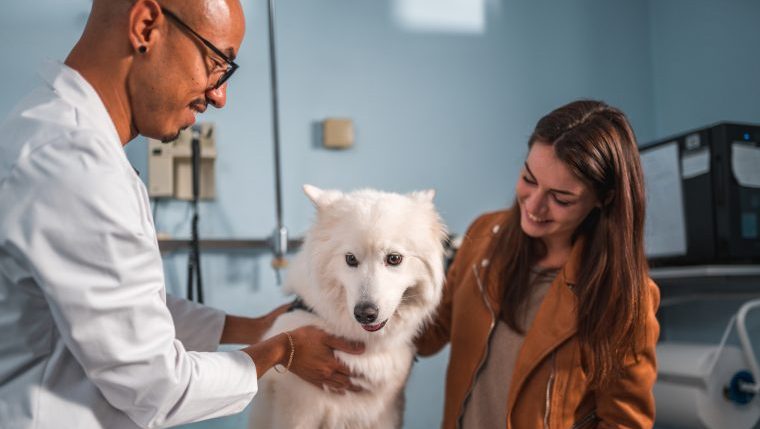
A Complete Guide to Vet Visit Costs for Dog Owners
By Erica Rivera
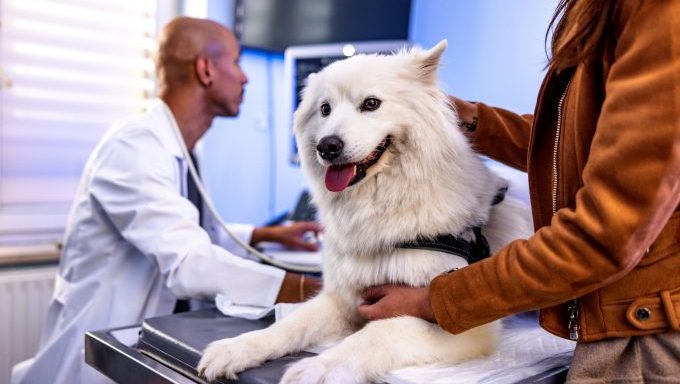
We know how much your four-legged friends mean to you; they’re not just pets, they’re family. And as part of the family, you want to ensure they’re healthy, happy, and well cared for. But let’s be honest: vet visits sometimes give us sticker shock. Whether it’s just a routine checkup, specialized treatment, or an emergency visit, veterinary care can add up quickly – and the worst part is, when you walk through the door of your vet’s office, you don’t always know what kind of a bill you’re going to get slammed with. But you pay it because you can’t put a price on your pup’s wagging tail and slobbery kisses, right?
All that said, being a dog owner shouldn’t bankrupt you. That’s why we’ve rounded up some facts, figures, and tips about vet visit costs so you can budget accordingly without skimping on your pup’s healthcare. Because at the end of the day, we can all agree that canine companionship is priceless.
Advertisement
Average cost of vet visits
First things first, let’s talk about the numbers. The average vet visit cost in the US ranges from $50 to $400, depending on various factors (which we’ll get into in a minute). Routine checkups usually fall on the lower end of the spectrum, while emergency visits and specialized services can cost a pretty penny.
Pawlicy Advisor has made a handy-dandy list of average vet visit expenses, which you can check out below.
Tests, examinations, and initial vet costs:
- Routine checkups: $50 to $250
- Spay/neuter: $160 to $220
- Vaccines per shot: $15 to $28
- Physical exams: $45 to $55
- Fecal exam: $25 to $45
- Heartworm test: $45 to $50
- Dental cleaning: $70 to $400
- Allergy testing: $195 to $300
- Geriatric screening: $85 to $110
And then there’s a whole other list of costs for big-ticket vet visits, courtesy of Emergency Vets USA .
Surgeries and unexpected vet costs:
- Bloodwork: $80 to $200
- X-rays: $150 to $250
- Ultrasounds: $300 to $600
- Short hospitalizations: $600 to $1,700
- Long hospitalizations: $1,500 to $3,500
- Wound treatment: $800 to $2,500
- Emergency surgery: $1,500 to $5000
- Oxygen therapy: $500 to $3000
Factors that affect vet visit costs
Here are a few things that can impact the cost of your pup’s vet visit:
Type of pet and breed: All dog breeds are created equal, but their vet bills aren’t! A Great Dane and a Chihuahua have vastly different healthcare needs. And certain breeds are prone to specific health issues that may require more frequent checkups or treatments.
Age and health condition of the pet: As your fur baby ages, their healthcare needs change, which can impact the cost of vet visits. Senior dogs may require more specialized care, and if your pup has an existing health condition, that can add to the bill as well.
Geographical location: Where you live can also affect the cost of vet care. If you’re in the city, you may pay more due to higher operating costs. But if you’re in a more rural area, you may have fewer options for vet care, which could also impact the price.
Type of service required: Whether your pup needs a routine checkup or emergency care, the type of service they require can impact the cost of their visit. Emergency visits and after-hours care can be particularly pricey.
How to save on vet visit costs
Here are a few tips for keeping your pup healthy without breaking the bank:
Consider pet insurance: Pet insurance can help offset the costs of vet care, so you don’t have to worry about a big bill when your furry friend needs care.
Shop around for vets: Different vets may offer different prices for the same services, so it’s always a good idea to shop around and compare prices.
Keep up with routine care: By keeping up with routine checkups and preventative care, you can help prevent bigger health issues down the line – and save money in the long run.
As you can see, it’s crucial to understand the potential costs associated with vet visits so you can plan and budget for your dog’s healthcare needs. By knowing what things cost ahead of time, you can make informed decisions about your dog’s veterinary care. Remember, investing in your dog’s health now can save you both cold, hard cash, and heartache down the road.
This article was written in collaboration with ChatGPT.
Erica Rivera's freelance writing has appeared in New York magazine, USA Today, the Star Tribune, City Pages, and many other publications and anthologies. She has interviewed hundreds of artists, authors, entrepreneurs, entertainers, and changemakers over the course of her career. She is also the author of Insatiable (Penguin Group, 2009) and Come Again (Thought Catalog Books, 2015). For more, visit: www.ericarivera.net .
Share article

Pros and Cons of a Cavapoo

4 Reasons Your Dog’s Tongue Sticks Out

Finding a Good Dog Breeder

Imodium for Dogs: Uses, Dosage, & Side Effects

Neighborhood Dog Dragged Away by Animal Control in Arizona

Popular Quiet Dog Breeds: Best Small Dogs for Apartments

Big Dog Breeds: The Top 10 Largest Dogs You Need To Know
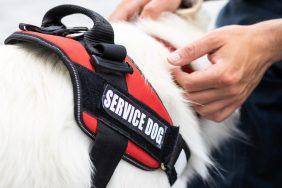
Types of Service Dogs: What They Do and How They Help

Best Apartment Dogs: Quiet, Low-Energy Dog Breeds Perfect for Renters
- Member Resources

How Much Does an Emergency Vet Visit Cost? (and How to Pay for It)
Jessica Foster | Oct 16, 2023
Emergency vet visits: the unexpected roller coaster ride of pet parenthood.
We've all been there – one minute, your cat is reenacting Olympic gymnastics on your curtains, or your dog has mistaken a bee for a chew toy, and the next, you're caught in a whirlwind of worry, Google searches, and financial stress.
But fear not, intrepid pet parents. You have options when it comes to covering hefty emergency vet bills.
In this article, we’ll be diving into the average costs of emergency vet visits – plus, how to pay for them.
From unexpected splurges to sneaky ways to save, we’ll break down the dollars and cents of those unplanned pet predicaments, ensuring your four-legged companion receives the care they deserve while saving you money.
Common Types of Pet Emergencies

But first, what is a pet emergency?
There are many situations that might warrant a trip to the emergency vet . These can range from sudden injuries to serious medical conditions. If your pet is experiencing any one of these conditions, it may be time to take them to the emergency vet clinic:
- Trauma and accidents: This includes sudden trauma such as being hit by a car, taking a long fall, getting attacked by another animal, breaking a bone, severe burns, etc.
- Respiratory distress: If your pet is having difficulty breathing, is choking on an object, or is having an allergic reaction leading to respiratory issues, take them to the emergency vet immediately.
- Gastrointestinal issues: Ingestion of toxic substances or swallowing foreign objects (e.g., toys, bones) can lead to severe gastrointestinal issues.
- Cardiovascular emergencies: If you notice that your pet is having a rapid or irregular heart rate, appears to be in shock, or has collapsed/fainted, this warrants an emergency vet visit.
- Neurological emergencies: Signs of a neurological emergency may include seizures or convulsions, sudden disorientation, inability to walk, and/or head trauma.
- Poisoning: Consumption of poisonous plants, chemicals, or toxic foods (e.g., chocolate, grapes, onions) may require a visit to the emergency vet.
- Severe allergic reactions: Swelling of the face, eyes, or throat and difficulty breathing may all be signs of a severe allergic reaction .
- Persistent vomiting or diarrhea: If your pet has persistent vomiting or diarrhea, or bloody or black stools, it may be time to take them to the emergency vet.
Other examples of pet emergencies

There are other types of pet emergencies that can occur, though this list is far from exhaustive. If your pet is acting unusual, appears to have a serious injury, or is unresponsive, take them to the emergency vet immediately.
- Heatstroke or hypothermia: e.g. overheating in hot weather or exposure to extreme cold
- Reproductive emergencies: e.g. birthing complications, dystocia (difficult or obstructed labour)
- Urinary emergencies: Urinary blockages in cats, urinary tract infections, blood in urine
- Eye injuries: e.g. eye infection, trauma to the eye, corneal ulcers
- Lacerations and wounds: e.g. deep cuts or punctures, excessive bleeding
- Sudden lethargy or weakness: e.g. unexplained weakness or inability to stand, sudden loss of energy
- Severe pain: e.g. crying out in pain, reluctance to move or be touched
- Severe dental issues: e.g. broken teeth, infections in the mouth
How Much Does an Emergency Vet Visit Cost?
Generally, emergency vet visits can range from a few hundred dollars to several thousand dollars , depending on the severity of the condition, the required treatments, and the area in which you're located.
Here's a breakdown of potential emergency types, along with average cost ranges for each. US prices have been converted to Canadian dollars.
Please note that these are general estimates and actual costs can vary significantly. Also, these estimates do not account for aftercare, follow-up visits, medication costs, or potential complications that may arise during or after treatment.
Factors Affecting Emergency Vet Costs
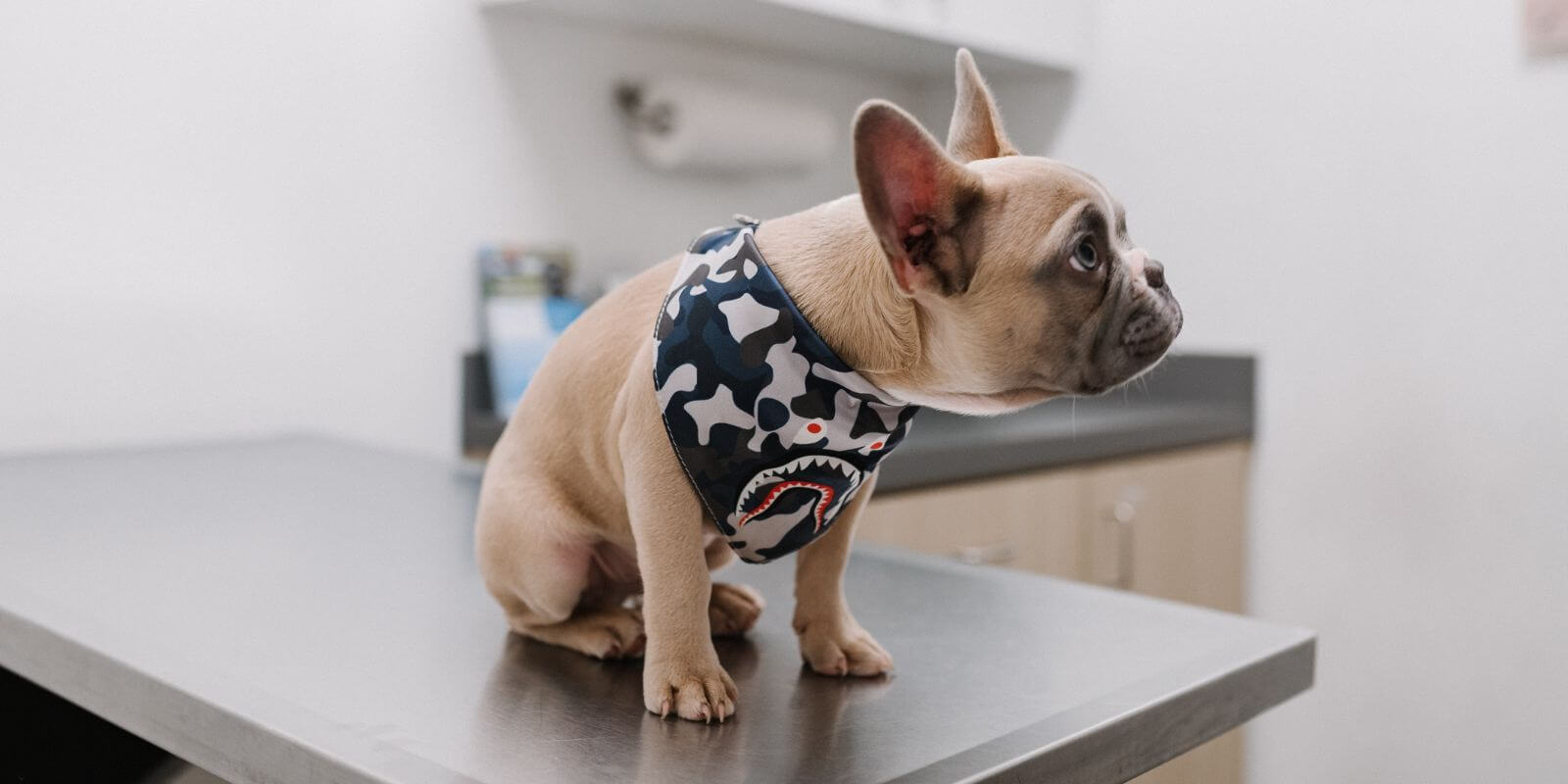
As stated, the table above reflects the estimated average costs for different types of vet emergencies. It’s always best to contact emergency vet services in your area to get a more accurate estimate of veterinary costs for your pet.
Here are some factors that can affect how much you will pay for an emergency vet visit:
- Type of emergency
- Severity of condition
- Diagnostic tests needed
- Required treatment procedure
- Whether hospitalization is needed
- Medications
- Specialist consultations
- Location of the vet clinic
- Time of day
- Equipment required
- Type of facility
- Size and type of pet
- Unforeseen complications
- Anesthesia or sedation
- Follow-up care required
How to Pay for Your Emergency Vet Bill

Dealing with an unexpected pet emergency can be stressful. Not only are you worrying about your pet’s health, you may be anxious about facing a massive emergency vet bill.
Fortunately, you have several options when it comes to covering emergency vet costs. While some situations may require you to pay out of pocket, it’s always worth it to do your research and learn about various payment options.
Here’s how to pay for an emergency vet bill, including several cost-saving options:
Step 1: Assess the situation
Before panicking about an emergency vet bill, slow down and try to assess the situation.
Evaluate the severity of the emergency and determine if immediate veterinary care is necessary. Is your pet facing a life-threatening situation? Or, is this a condition that can be remedied through a regular vet visit?
If it is an emergency, seek emergency veterinary care right away. If you are not sure, call your local veterinarian for their expert opinion.
Step 2: Contact your veterinarian
Once you’ve determined your pet is facing a medical emergency, call your veterinarian or an emergency animal hospital to inform them about the situation. They can provide guidance on when and how to bring your pet in for treatment.
If possible, ask the vet for an estimated cost of the emergency treatment based on the information you provided. Keep in mind that they may not be able to provide an estimate until they evaluate your pet in person.
Step 3: Evaluate payment options
Most veterinary clinics and hospitals will inform you of the various payment options available. Sometimes, they may even provide payment assistance programs to pet parents in need.
Here are a few common payment methods for covering emergency vet bills:
- Cash, debit, or credit card: If you have the funds available, paying with cash, a debit card, or a credit card is a straightforward option.
- Pet insurance: Check your pet insurance policy to see if the emergency is covered. Contact your insurance provider to understand the reimbursement process and coverage limits.
- CareCredit: You may wish to consider applying for a medical credit card that offers special financing options for veterinary expenses such as CareCredit ™*. Review terms, interest rates, and repayment options to ensure this is right for you.
- Payment plans: Inquire if the veterinary clinic offers payment plans to spread out the cost over time. Ask them about any associated fees or interest.
- Crowdfunding: If needed, you can explore crowdfunding platforms like GoFundMe ™* to seek financial assistance from friends, family, or people on social media.
- Personal loans: Evaluate the option of taking out a personal loan from a bank or credit union. Understand the interest rates and repayment terms.
- Veterinary payment assistance programs: Research charitable organizations that provide financial assistance for pet emergency expenses. Ask your vet about eligibility and application requirements.
- Family and friends: Consider reaching out to family members or friends who might be willing to help financially. A little help can go a long way.
- Negotiation with the veterinary clinic: Depending on the situation and clinic policies, you might be able to negotiate a payment plan or discuss options for reducing costs. However, this may not always be possible.
Once you’ve evaluated the available payment options and have the estimated cost of treatment, it’s time to make an informed decision on how to proceed with your pet's care. If needed, discuss your concerns with the veterinarian or their staff. They may be able to provide helpful advice or assistance.
Step 4: Keep records
No matter what payment option(s) you choose, always keep a record of your emergency vet payments. Save copies of all communications, estimates, receipts, and payments. These records may be needed for future reference and potential pet insurance claims.
Step 5: Plan for the future
Once the emergency is resolved, take time to review how the situation was handled and explore ways to prepare for future pet emergencies.
This may include signing up for pet insurance, which can help you cover the costs of unexpected pet illnesses, surgeries , and other types of emergencies in the future. Furkin Pet Insurance helps pet owners cover up to 80% of eligible expenses, providing the care pets need and the cost savings you deserve.
How to Prepare for and Reduce Emergency Vet Costs

You can’t always anticipate a pet emergency, but there are steps you can take now to prepare for the future. By investing in your pet’s health, signing up for pet insurance, and creating a wellness budget, you can help prevent the occurrence and costs of a pet emergency.
Here are a few tips for how to prevent, prepare for, and/or reduce emergency vet costs:
Do your best to prevent pet emergencies
Reducing emergency vet bills involves proactive pet care, preventive measures, and knowing how to respond to potential health issues. Prevention is one of the best ways to avoid costly emergency vet bills.
Here are some strategies to help you minimize the likelihood of emergencies and manage costs:
- Maintain regular veterinary care: Schedule regular check-ups and vaccinations for your pet. Preventive care can catch health issues early, saving you from potential emergencies down the line.
- Keep up a healthy lifestyle: Provide your pet with a balanced diet, regular exercise, and mental stimulation. A healthy lifestyle can prevent obesity and reduce the risk of certain health problems.
- Pet-proof your home: Remove hazards and toxic substances from your home to prevent accidents and poisoning. Keep harmful plants, chemicals, and small objects out of reach.
- Supervise your pet: Supervise your pet during outdoor activities and walks to prevent accidents and altercations with other animals. Use a leash and harness to prevent them from wandering off, eating toxic materials, etc.
- Spay or neuter your pet: Spaying or neutering your pet can reduce the risk of certain health issues, such as certain cancers and reproductive emergencies.
- Keep up with dental care: Maintain good oral hygiene to prevent dental issues. These can lead to serious health problems if left untreated.
- Use parasite prevention: Use flea, tick, and heartworm preventives as recommended by your veterinarian to reduce the risk of parasitic infections.
- Learn pet first aid: Learn how to respond to minor injuries or illnesses to prevent the need for immediate vet visits.
- Microchip your pet: Microchip your pet to increase the chances of a safe return in case they get lost.
- Take pet safety classes: Attend pet safety and first aid classes to learn about, prevent, and prepare for pet emergencies.
Create a pet emergency budget

Building a pet emergency budget is another way to prepare for future vet bills. However, this is not foolproof, as you can’t always estimate the cost of emergency vet bills. For example, if you chose to save $50 a month, after two years you would have saved just $1200, yet many unexpected veterinary expenses can far exceed that amount saved. This also assumes you never had to tap into the “pet savings fund” for other unexpected expenses such as home or car repairs. Subscribing to comprehensive pet insurance is the best way to cover your pet’s needs and prepare for unexpected vet costs.
That said, having some money saved up could help you pay your deductible or cover out-of-pocket expenses before you’re reimbursed by your pet insurance company.
Here are some tips for creating a pet emergency budget:
- Consider establishing a separate bank account for pet emergency savings. Alternatively, you can stow away cash in a safe place, like a safe or piggy bank.
- Research and add up the average costs of common emergency situations and treatments in your area. This can include things like X-rays, bloodwork, wound treatment, and surgical procedures. Look at both minor and major emergencies to get a better idea of the potential range of expenses.
- Factor in your pet’s current health. If your pet has any pre-existing conditions or is prone to certain health issues, you might want to save more in anticipation of potential emergency care related to those conditions.
- If you have pet insurance, consider the deductible amount. Your emergency fund should ideally cover the deductible in case you need to file a claim.
- Assess your monthly budget and determine how much you can comfortably set aside for your pet's emergency fund. It's better to save a smaller amount consistently over time than to not save at all.
Sign up for Pet Health Insurance
Signing up for pet health insurance is one of the best ways to reduce the out-of-pocket costs for an emergency vet visit. At Furkin, you could get up to 80% of your total vet expenses covered during a pet emergency.
Furkin Pet Insurance helps ensure that your furry companions receive the necessary medical care they need during an emergency, without overwhelming you with emergency vet costs. Furkin's pet insurance coverage offers financial protection against many emergency situations, including unexpected accidents, illnesses, and injuries.
With quick reimbursement and flexible plans tailored to individual needs, Furkin Pet Insurance provides a safety net that allows you to focus on providing the best care for your pet!
Research your options
Worried that you can’t afford your emergency vet bill? You have options .
While we’ve already covered some common payment options (like payment plans, personal loans, or crowdfunding), there are a couple of alternative options to consider. We always recommend doing your research to look for programs, wellness plans, and discounts in your area or online.
Here are a few creative ways to cover emergency vet expenses:
- Plan a community fundraiser: Organize a community fundraiser or crowdfunding campaign to raise funds for your pet's emergency expenses. Engaging friends, family, neighbours, and local pet lovers can help spread the word and attract support.
- Check out pet-assistance charities: Research and reach out to pet-assistance charities, foundations, or nonprofit organizations in your area or online. Some organizations offer grants or financial assistance to pet owners in need.
- Barter or trade services: If you have skills or services that can be bartered or traded, consider offering your services in exchange for assistance with your pet's emergency bills. This could include pet-sitting, dog walking, or other services.
- Research local pet clubs: Check if there are local pet clubs, organizations, or associations that offer support for pet owners during emergencies. They might have resources or contacts that can help.
- Visit veterinary school clinics: Veterinary schools often have teaching clinics where students, under supervision, provide veterinary care at reduced costs. This could be an option for more affordable emergency care.
- Join an online pet community: Join online pet communities and forums where pet owners share experiences and advice. These communities might have resources or ideas for covering emergency costs.
Save Money with Emergency Pet Insurance
And there you have it, dear pet parent – a crash course in the realm of emergency vet visit costs. From weathering pet emergencies to wrangling those unexpected bills, you're now equipped with the resources you need to prioritize your pet’s health without burdening your pocketbook.
But before we wrap up, let's not forget our secret weapon in this budget battle: pet insurance.
With Furkin emergency pet insurance by your side, those unpredictable pet predicaments can become a lot more manageable. We cover a range of pet emergencies, from trauma and injuries, or allergies and illnesses. So go forth, pet parent, with the savvy savings tactics and handy sidekick of Furkin insurance. Because when it comes to your pet's health and your wallet's well-being, there's no adventure too wild to conquer.
*Furkin is not affiliated with CareCredit or GoFundMe and does not endorse or recommend these products.
Related Articles:

Everything You Need to Know About Emergency Pet Insurance
Emergencies happen to everyone, and pet insurance helps cover a good portion of the veterinary...

How Often Should I Take My Dog or Cat to the Vet?
As a pet owner, you might know to bring your pet to the vet in case of emergency or to catch up...
Up to $20,000 in annual coverage
Up to 80% of your vet fees covered
3 deductible options to choose from
You and your pet can bounce back from an accident or illness with our really simple coverage.
If you’ve looked at pet insurance coverage before, but didn’t bite – it’s time to get some Furkin Pet Insurance!
Be a smarter pet parent
Next time, skip the web. Get health tips and wellness advice for your pet straight to your inbox.
- dog parent basics
How much does a vet visit cost?
Know what different types of veterinary care might cost you
— Medically reviewed by Dr. Leslie Brooks
Everything we create is factually accurate and biased toward science → meet our team of experts
Updated September 13, 2023
Most people don’t consider their dog or cat a major expense. But one in three pet owners spend between $800 to $1,500 each year on emergency veterinary treatment alone¹. Whether you’re an experienced pet parent or just getting started, this resource will help you plan for the unexpected, so you aren’t caught off guard.
- Basic office visits
- Checkups & preventative visits
- Common medical conditions
- Breed-specific health issues
- Ways to save on vet visits
Pet insurance
Share this image on your site.
</p> <p><strong>Please include attribution to https://betterpet.com/ with this graphic.</strong></p> <p><a href=’https://betterpet.com/costs-of-veterinary-care/’><img src=’https://betterpet.com/wp-content/uploads/2020/03/V1-4.png’ alt=’Guide to the cost of vet visits for dogs and cats’ width=’1000px’ height=’1500px’ /></a></p> <p>
Covered in this report
- A ballpark idea of what routine, preventative, and emergency care for your pet might cost
- Common breed-specific conditions to watch out for
- Ways you can save money in the long-run
Basic office calls
The initial office call is either a routine checkup or a consultation based on your pet’s symptoms. The office call only covers the cost of setting an appointment and a physical examination of your cat or dog during regular business hours.
the cost of veterinary office calls
Things to remember
- Statistically speaking, cats are typically more affordable than dogs, but there are factors to consider, such as breed, age, and other health needs.
- Some veterinary offices keep the office visit quote low, knowing that pet owners will eventually come in and spend more on treatment.
- Routine care usually includes the consultation and extended exam. The only exception is if it’s a followup visit or the veterinarian is already aware of your pet’s history, in which case it would be cheaper (around $30-$40).
Annual checkups and preventive care
Much of the cost of checkups come from the type of visit, whether it’s a basic consultation, or also includes new vaccinations, or additional testing, all of which cost extra. Quotes may also differ according to the dog or cat breed.
Core and booster vaccinations
Veterinarians will determine a vaccine schedule, including core vaccinations and boosters. Boosters are given to kittens and puppies for 3 to 4 weeks until they are at least 16 weeks of age. However, not all vaccinations require boosters.
the cost of pet vaccinations
- Local authorities may require specific vaccines and documentation of those shots. For example, some cities may require rabies shots every year or every three years.
- The ASPCA highly recommends core vaccinations in preventing common pet diseases . Vaccines help your pet’s immune system resist the invasion of disease-carrying organisms through antigens, which stimulate the immune system and help fight real infection later on.
Core vaccines for dogs
- Parainfluenza
Core vaccines for cats
- Panleukopenia
- Rhinotracheitis
- Calicivirus
- Feline Leukemia
Heartworm testing
Heartworm testing checks for parasitic worms, which can lead to heartworm disease. Protecting your pet requires a blood test to check antigen levels, as well as a Difil test, to check for the presence of microfilaria.
the cost of a heartworm test
Fecal exams.
Fecal exams focus on finding gastrointestinal parasites rather than those in the blood. A stool sample will be collected from your pet and analyzed under a microscope.
Common types of parasites found in dogs and cats
the cost of fecal exams
Dental cleaning.
Veterinarians will point out visible evidence of gingivitis in a cat or dog’s mouth. Yearly cleaning can prevent gingivitis and bleeding gums.
the cost of dental cleanings
Geriatric screening and other tests.
Dogs and cats over seven years of age may require geriatric screening, which is a more in-depth examination that includes blood work, a urine analysis, and X-rays
the cost of geriatric screenings
Allergy testing.
Pets can develop allergies just like their owners and may show symptoms, like sneezing, itching, or over-licking themselves. Veterinarians can detect allergy sensitivities with either a blood test or an intradermal skin test. Vets believe that skin tests have higher accuracy since a pet reacts to allergens directly.
the average cost of allergy testing
Ear infections in cats and dogs are indicated by symptoms of constant scratching, ear-rubbing, discharge from the ears, swelling or redness, head shaking, and odor. Testing can determine the type of ear infection, and whether it’s mites, bacteria, or a yeast infection.
the cost of ear exams + medication
Flea control.
Flea testing usually just involves visual inspection.
the cost of flea control medication
Spay and neuter costs.
Spay surgery prevents unwanted pregnancies, stray male attention, and even reduces the chance of breast cancer and uterine infections (pyometra). Neutering eliminates spraying, reduces prostate problems, testicular cancer, and can help temper behavior.
spay and neuter costs
Diagnostic testing (lab tests).
Diagnostic tests are essential, particularly lab tests, because the veterinarian needs a “baseline” check of a pet’s regular health to compare the results to changes later on.
the cost of laboratory testing
The exam (or extended exam).
- Pet is weighed on a scale
- Temperature is taken
- Eyes (Any signs of inflammation)
- Nose (Congestion)
- Mouth and teeth (Gum inflammation, tartar or breakage)
- Ears (Drainage, mites or inflammation)
- Heart and lungs (Murmurs or respiratory problems)
- Fur, paws, feet (Damaged or broken limbs)
- Backside, anus (Fleas or worms, bumps or lumps)
Other tests
- Urinalysis. A urine test for detecting urinary tract infection as well as other metabolic problems indicated by the appearance of proteins, sugars or blood particles
- Fecal matter. A stool sample tests for detecting parasites and worms.
- Complete Blood Count. Evaluates red cells, white cells, and platelets, as well as parasites or other invasions (Detects anemia, infection, leukemia, heartworms)
- Blood Chemistry Panel. Tests electrolytes, liver enzymes, glucose and protein levels, kidney values (Detects liver, kidney or gallbladder issues, endocrine diseases, and diabetes)
In-depth diagnostic testing
Testing for serious diseases might require diagnostic imaging services, like an ultrasound or radiograph/biopsy. Some vets also offer genetic testing for certain breeds to determine their predisposition to diseases.
the cost of diagnostic imaging
Common medical conditions for dogs and cats.
It may also help to consider each unique condition, according to the most common problems in cats and dogs, as well as problems genetically associated with common breeds.
10 common medical conditions for dogs 🐩
10 common medical conditions for cats 🐈, breed-specific considerations.
Different breeds have a proclivity to certain conditions. Knowing which of these genetic influences will help you plan and budget accordingly.
Dog breeds with a high risk of health problems 🐩
Know which conditions your pet might be prone to
Cat breeds with a high risk of health problems 🐈
Emergency vet visits.
The cost of an ER visit varies wildly depending on the situation, but you can almost count on a bill of $500 or more.
the cost of your pet’s trip to the emergency room
Dogs and the er 🐩.
The 5 most common reasons dogs go to the emergency room
- Trouble breathing (heart failure, toxins, cancer) radiographs
- Collapse or paralysis
- Seizures (epilepsy, brain tumors, low blood sugar or electrolyte imbalance)
- Vomiting or diarrhea (gastrointestinal problems, intestinal blockage, cancer)
- Choking (Lung problems, heart failure, bacteria or viruses)
Cats and the ER 🐈
The 5 most common reasons cats go to the emergency room
- Urinary blockage (Inflammation, cancer, blood clots)
- Pain (Spinal problem or blunt force trauma)
- Labor difficulty
- Allergic reactions (insect bites or vaccine allergy)
- Infection from an animal bite
Sign up for the best pet advice you can get
Ways to save money on vet visits
Out-of-pocket costs for life-saving treatment can easily hit the $3,000 mark, especially if your pet has an ongoing condition that requires regular medication. Here are the most important things you can do to keep your pet healthy and prevent unexpected (and unnecessary) vet costs throughout your pet’s life.
Get the fundamentals right
The best thing you can do for your pet and your wallet is to focus on the basics of preventive care:
Buy high-quality food — A healthy diet is key. Talk with your vet about whether your pet has any special nutritional requirements.
Don’t skip wellness checks — Taking your pet to the vet before they’re sick is one of the best ways to make sure that you don’t spend tons of money at the ER later in life. Consider taking your pet for a wellness exam at least twice a year.
Exercise regularly — Walk your dog and play with your cat. Exercise and diet help prevent diabetes, obesity, and arthritis.
Keep your home free of toxins — Be mindful of potential toxins in your home, from cleaning supplies to food crumbs. Maintain your yard and clean the house regularly to reduce your risk of parasites.
Create an emergency budget
Shop around and compare vet prices.
All vet clinics calculate their costs differently. Always shop around for a second and third opinion. You have a right to ask for a referral or even the contact number of another vet who can give a second opinion. It’s unlikely the vet is price gouging you, so they will have nothing to hide.
You can also ask for a written diagnosis rather than buying treatment in the office directly. Price compare medications from online stores, which don’t have to plan for store overhead and do frequently have much lower prices.
👉 Pet insurance can save you thousands on emergency treatment, but unlike human health insurance, it doesn’t cover routine and preventative care .
the cost of pet insurance
How pet insurance works.
The main difference between human insurance and pet insurance treats is that the latter classifies your pet as property. This might not sound great (pets are family, after all), but it can be advantageous because you have complete freedom over the vets and policies you choose. There’s no such thing as an out-of-network vet.
Another thing to remember is that most veterinary offices require payment upfront. On top of that, most pet insurance providers make you pay 100% out of pocket, then give you a refund afterward. You can ask your vet office if they will postpone payment until the insurance company pays their portion, and it’s a fifty-fifty shot, depending on how well the veterinary staff knows you and what the total expenses are.
A note on pre-existing conditions
Most pet insurance companies will not cover pre-existing conditions.
Make sure the company clarifies what constitutes a pre-existing condition, and ask about what’s on your pet’s medical records since the insurance company will have access to them. Insurance companies typically require a vet checkup before providing coverage.
Waiting periods can range from 24 hours to 14 days, or even one year, depending on the type of medical condition covered.
Lastly, ask about maximum payouts, as these could be calculated per incident, or so many claims a year, or even a lifetime of the policy. The higher the premiums, the better the payouts, but premiums also rise with a pet’s advancing age.
The bottom line on pet insurance
The bottom line is that pet insurance is only worth it if you seek it out early on when a cat or dog is healthy and has been fully vaccinated and cared for most of its life. When a major disaster happens, you get the money back from the company — and on average, it’s more than the total of the premiums you paid over your pet’s lifetime.
👉 One of the best alternatives to pet insurance is Pawp — for $19 a month, pet parents get 24/7 and unlimited access to licensed vets, plus an annual $3,000 emergency fund.
Dog wrinkles are adorable but need extra love and care. Here are some ways to keep your dog’s wrinkles healthy.
Not all breeds are double-coated — but if your dog is, knowing the right grooming techniques can go a long way towards preventing tangles and knots.
Unleash success with our comprehensive guide to integrating a new caregiver into your pet’s life.
Professional grooming can benefit dogs of all coat types. Keep reading to learn when you should take your furry friend to the groomer.
How Much Do Dog Emergencies Cost In A veterinary Clinic?
Every dog owner must realize that taking care of a dog is not an easy task and require minimum care. Instead, getting a dog as a pet takes a huge responsibility and money.
Though some dog parents have prepared a budget for a necessary care including routine checkups, vaccines, or tests, but it’s rare to find a dog parents prepared for the emergency budget for their canine friends.
When your dog is injured and requires an emergency visit to a vet, the last thing on your mind is how much will it cost to make them better?
How much can a dog emergency cost?
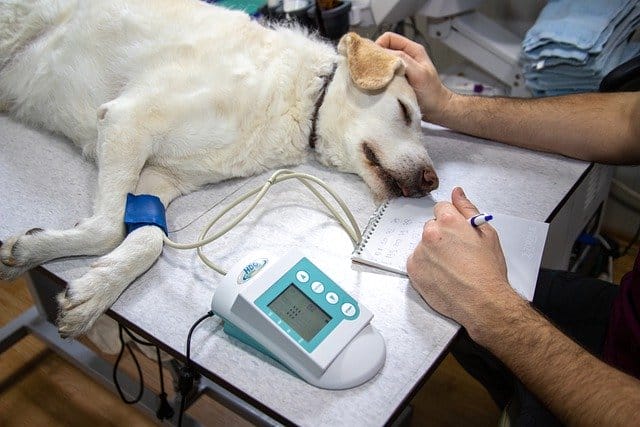
Well, before answering that question, there are several causes that make your dog visit veterinarians immediately.
Common dog emergencies
Every dog parent wants their beloved dog to always be in good shape. But that’s just a wish!. Sometimes an accident occurs, that makes you have to take your dog to a veterinarian immediately. And here are some common causes for a dog sudden visit to a veterinarian
- Vomiting and diarrhea
Vomiting and diarrhea are the most common reason that dogs are brought to the veterinarian for emergency evaluation. There are many causes for dog vomit and diarrhea, including poison, dysfunction of the internal organs, allergies , etc.
- Trauma and injuries
Another common cause of emergency visits is trauma and injuries, including a simple dog bite, broke their leg , or worse after being hit by a car. For serious injuries can lead your dog to be hospitalized and surgery.
- Sudden weakness or collapsed
There are many reasons for a dog’s sudden weakness and collapse, including neurologic issues, breathing difficulties, and toxin ingestion. These conditions require hospitalization for your dog.
The cost of emergency veterinary care
The cost of the veterinary emergency visit varies from one clinic to others. There are so many reasons why it’s different for each veterinarian to charge, such as location, dog breed, dog size and many others. And here the estimated range cost for an emergency veterinarian visit.
For dog check, tests and exams
And for emergency treatments
(Note that they are based on the USA costs)
Based on the table above, you can see that the emergency veterinary visit is so expensive and could drain your bank account.
How to afford an emergency Budget
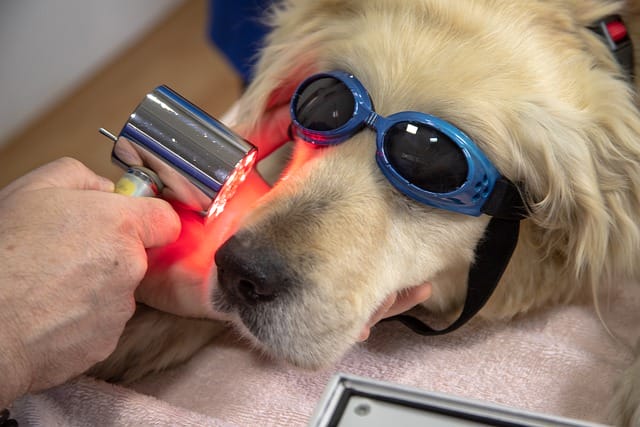
Pet insurance is the popular and the best option to cover any sudden expense caused by an emergency visit to the veterinarian.
There are many pet insurance that can cover your needs with multiple plannings, offers and services. Pet insurance like Embrace and Lemonade are popular pet insurances that have a good service, affordable based on your financial capabilities. And there are still tons of pet insurance that are worth checking as well.
There are many reasons for a dog to have an emergency visit to the veterinarian. The bad news is some dog parents are not prepared for a sudden expense caused by an emergency visit.
And the best option and solution is to have pet insurance to cover all the sudden expenses caused by your dog’s sudden accidents that need to take them to visit a veterinarian. There are so many pet insurance companies with various offers and multiple payment plans.
Leave a Reply Cancel reply
Your email address will not be published. Required fields are marked *
Save my name, email, and website in this browser for the next time I comment.
Post Comment
GIPHY App Key not set. Please check settings
We are a participant in the Amazon Services LLC Associates Program, an affiliate advertising program designed to provide a means for us to earn fees by linking to Amazon.com and affiliated sites. © 2024 PetPress. All Rights Reserved.
With social network:
Or with username:.
Username or Email Address
Remember Me
Don't have an account? Register
Forgot password?
Enter your account data and we will send you a link to reset your password.
Your password reset link appears to be invalid or expired.
Privacy policy.
To use social login you have to agree with the storage and handling of your data by this website. %privacy_policy%
Add to Collection
Public collection title
Private collection title
No Collections
Here you'll find all collections you've created before.

Pet Emergency Statistics and Veterinary Costs
Accidents happen – it's true, but they don't always have to. We're sharing the statistics and rough cost ranges of some of the more common pet emergencies below because, for many pet owners, costs are a large factor in the amount and type of care their pets are able to receive.
Prevention isn't always possible, but it often is – and it's often as simple as having prior awareness and taking simple precautions. The goal of Preventive Vet is to help save cats' and dogs' lives, so have a look here and then browse around the rest of the site to find articles and resources that can help you keep your pets healthy, happy, and safe.
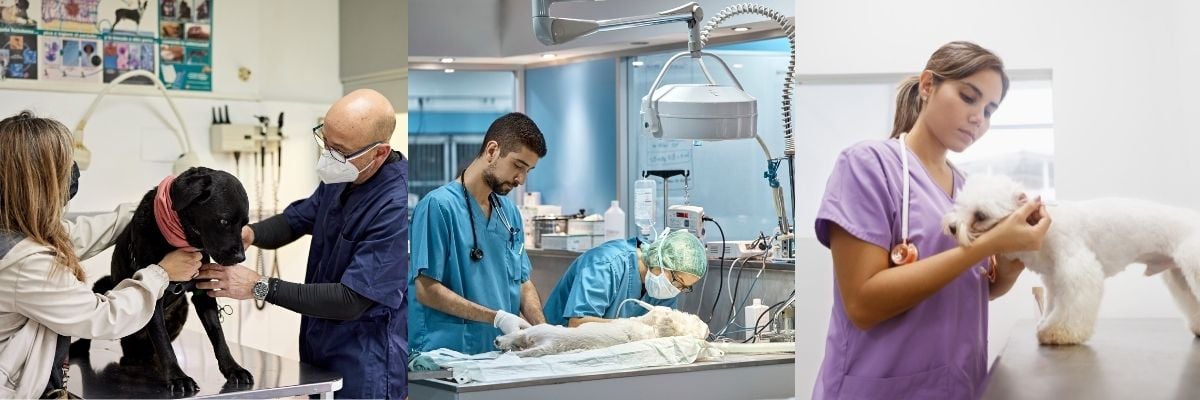
Pet Emergency Statistics
Vomiting and diarrhea.
Nationwide, vomiting and diarrhea are routinely among the top 10 reasons that pets are brought to the veterinarian for emergency evaluation and treatment.
These are in fact just the outward signs of any number of potential underlying problems – including irritation or obstruction of a pet's intestinal tract, ingestion of a poisonous substance, dysfunction of one or more internal organs, and a variety of others. Many of the most common causes of vomiting and diarrhea in pets can be easily prevented.
There are no official statistics kept on the subject, but based on the frequency with which they are seen in emergency rooms across the country, it is safe to assume that there are tens, if not hundreds, of thousands of cats and dogs injured or killed in road traffic accidents each year in this country.
Equally as important are the accidents that unleashed dogs and outdoor cats cause each year, many of which result in significant injury or even death to people.
Life expectancy of cats
Several sources estimate that the life expectancy of an outdoor cat is only 2–5 years. By contrast, the life expectancy of an indoor-only cat is nearer 12–18 years (even up to 20 years!). Amongst other things, cats that go outdoors unobserved are at greater risk of eating or licking up something poisonous (e.g., antifreeze, lilies, rat and mouse poisons, and others), and they're at greater risk of getting into a fight with a dog, wildlife, or another cat, and they're at risk of being hit by a car.
Antifreeze toxicity
The Humane Society Legislative Fund estimates that over 10,000 dogs and cats die each year from exposure to antifreeze containing ethylene glycol.
This harmful substance can be found in lower and less harmful concentrations in windshield de-icing fluids, motor oils, hydraulic brake fluid, paints, solvents, wood stains, etc. One lick (0.64 ml/lb) of this highly poisonous substance can be enough to cause irreversible kidney failure and death in a cat. Severe acute kidney failure can occur in dogs that consume 1 tablespoon.

Pet toxicities
The ASPCA's Animal Poison Control Center, the pioneer in pet poison control, has handled over 4 million cases since its beginnings in 1945. In 2021, there was a 22% increase in call volumes and they received over 401,550 calls related to pet exposures to toxic substances. Many of these calls were related to common household products that are likely present in your pet's environment right now.
In 2019 the ASPCA Animal Poison Control Center helped over 232,000 animals.
These were the top 10 pet toxins reported:
- Over-the-counter medications such as painkillers (ibuprofen, Tylenol®), joint rubs, and herbal supplements were 19.7 % of cases (about 45,704)
- Human prescriptions (heart, thyroid, ADHD, and antidepressant medications) were 17.2 % of cases (about 39,904)
- Food ( xylitol , grapes , raisins, onions , garlic, and protein bars) was 12.1% of cases (about 28,072)
- Chocolate was 10.1% of cases related to sweet treats. Per day, it averages greater than 67 cases
- Veterinary-related products accounted for 9.3% of cases (about 21,576)
- Household items were 7.7% of the cases (about 17,864)
- Rodenticides were 6.8 % of cases (about15,776). These cases increased in 2019 from prior years.
- Plants were 6.1% of cases (about 14,152). These cases have moved up in order and often involve cats and lily exposure .
- Insecticides were 5.1% of cases (about 11,832). These cases have dropped due to the fact that there are safer alternatives and homeowners have better handling and safety protocols in place.
- Garden products (fertilizer, soil enhancements, herbicides, etc.) continue to remain on the top ten list at 2.4 % of the cases (about 5,568).
Pet Emergency Veterinary Costs
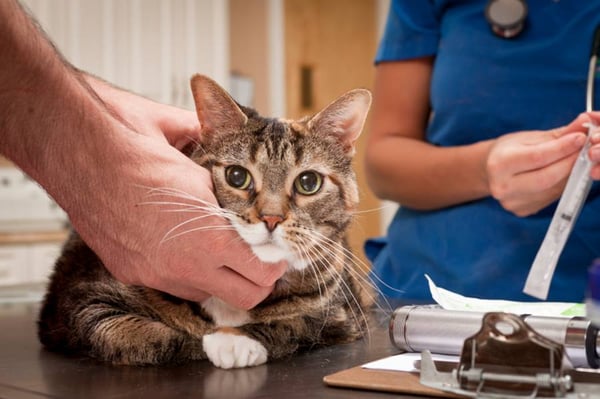
ER exam: ~ $100 – $200
IV catheter: ~ $60 – $75
IV fluids (per bag): ~ $60 – $95
Blood tests (basic): ~$80 – $200
Urine tests (basic): ~$40 – $70
X-ray (basic): ~$150 – $250
Ultrasound: ~ $300 – $600
Blood pressure measurement: ~ $25 – $75
Pain medication: ~ $40 – $80
Oxygen Therapy: ~ $500 – $3,000
Wound treatment and repair: ~ $800 – $2,500
Emergency surgery (bloat, foreign body, hit by care, caesarian): ~ $1,500 – $5,000
Hospitalization and monitoring:
1–2 days (vomiting, diarrhea, seizures cases): ~ $600 – 1,700
3–5 days (parvo, blocked cat, kidney failure): ~ $1,500 – $3,500
Accidents & Emergencies Happen
Pet accidents and other emergencies are common when their people are out of town. So whenever traveling without your pets, always make sure to leave them in the care and close supervision of a responsible person or company. And always be sure to fill out and leave behind a Treatment Authorization Form , so your pets can get the medical care they need in the event of an unforeseen problem when you can't be reached. When filling in the section of the form with the amount that you authorize the pet sitter or caregiver to approve in your absence, please take into account the rough minimal costs of some of the typical emergency evaluations and procedures as listed above, as well as the following common emergencies.
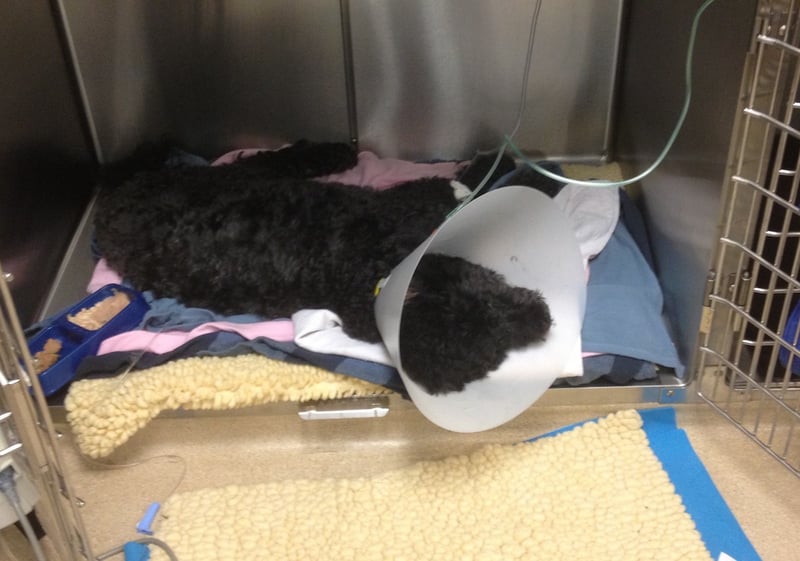
Approximate emergency veterinary treatment ranges
Vomiting, diarrhea, and gastrointestinal:.
Food bloat: $500 – $1,000+
Gastric Dilatation and Volvulus (GDV): $2,000 – $7,500+
Gastroenteritis: $750 – $3,000+
Intestinal obstruction with surgery: $3,000 – $4,000+
Pancreatitis: $2,000 – $5,000+
Toxin Ingestion:
Antifreeze: $2,000 – $6,000+
Chocolate: $250 – $2,000+
Grapes & Raisins: $2,000 – $5,000+
Human antidepressant medications: $1,500 – $2,500+
Human pain medications: $250 – $2,000+
Lilies (cats only): $1,000 – $4,000+
Rat and mouse poison: $750 – $4,000+
Slug bait: $1,500 – $4,000+
Xylitol: $750 – $4,000+
Cat bite abscess: $300 – $1,500+
Dog bite wounds: $1,000 – $10,000+
Electrical cord shock: $500 – $3,000+
Heatstroke: $1,500 – $6,000+
High-rise fall: $500 – $6,000+
Hit by car: $250 – $8,000+
Urinary Issues:
Urinary tract obstruction: $1,500 – $3,000+
Uterus & Birthing Issues:
Birthing difficulties (caesarian section): $1,500 – $3,500+
Uterine infection (pyometra): $1,000 – $3,000+
Hepper is reader-supported. When you buy via links on our site, we may earn an affiliate commission at no cost to you. Learn more .
Average Cost of a Vet Visit for Dogs in 2024: Updated Price Guide

By Nicole Cosgrove
Updated on Jan 2, 2024
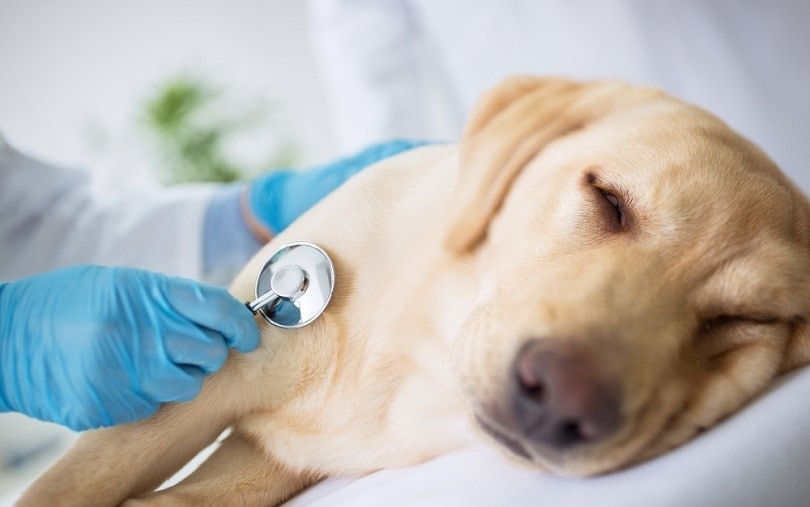
From food to toys and accessories, the cost of owning a dog can quickly add up. When you add in veterinary visits, it can become surprisingly expensive. Most people make the mistake of assuming that owning a dog is inexpensive — just buy a few toys and budget for food costs, and you’re good to go. But there are more costs that need to be taken into consideration — most importantly, the costs concerning your dog’s health and well-being.
How Much Is a Vet Visit for a Dog?
The cost of a vet visit for your dog can vary widely depending on the context. Is your dog simply going in for a routine checkup, or is there something more serious at hand? Aside from routine vaccinations, your dog will need to go for regular checkups at least once or twice a year, and you can expect to pay between $50-$100 per visit.
Over time, visits to the vet can really add up. If you're looking for a good pet insurance plan that won't break the bank, you may want to look at Lemonade . This company offers adjustable plans customized to your pet's needs.
- Check vital signs, including temperature, pulse, weight, and respiration.
- Do a physical examination, with a head-to-tail inspection of your dog’s coat, legs, and joints to check for any swelling or pain.
- Make sure your dog’s vaccinations are up to date.
- Do diagnostic health screenings depending on your dog’s age, including blood count, urinalysis, and X-rays.
Depending on your dog’s age and condition, your vet may recommend additional diagnostics, including a biochemistry profile and thyroid hormone testing. For older dogs, these may include additional X-rays to check for any joint degeneration.
- Dental cleaning . Routine dental cleaning is highly recommended to prevent dental disease and can range from anywhere between $300-$800, depending on the severity.
- Heartworm tests . Most vets recommend this test at least once annually, and it usually costs around $50 for a blood sample to be sent to a lab. Heartworm is a serious disease, and this is a relatively low cost to make sure your dog is all clear.
- Fecal examinations . Also recommended at least once annually, fecal exams are helpful for checking whether your dog has any parasites, such as hookworms. They typically cost between $25-$50.
Standard Vet Procedures Regional Pricing Sheet
Source: https://www.banfield.com/Services/price-estimator
Additional Vet Costs for Dogs
If your vet discovers anything out of the ordinary during a routine checkup, there will likely need to be additional tests and thus, additional costs. In general, your vet will only need to perform additional tests if they need to narrow down the issue with your dog so they can prescribe a sufficient treatment. Sometimes, though, they may know what’s wrong right away. Still, there may be a procedure or medication that is required, which can result in extra costs.
- Tooth extractions. Your dog may have damaged a tooth, have tooth decay, or have an infection and need to have a tooth removed. The fees for this procedure can depend on several factors, including the breed and temperament of your dog, the severity of the infection, and which part of your dog’s mouth is affected. In general, you can expect to pay as little as $40 or up to $400 for severe cases.
- Geriatric screenings. For dogs 7 years or older, your vet will usually recommend a geriatric screening. This is a more comprehensive checkup that involves complete bloodwork, X-rays, urinalysis, fecal analysis, etc. You can expect to pay $80-$120 for this additional screening.
- Allergy testing. Your vet may suspect that your pooch has an allergy of some kind and will need to perform a test. This is done with either an intradermal skin test, which can cost between $200-$250, or a blood test, which can typically cost around $200-$300.
What to Expect Financially From an Emergency Vet Visit
If your dog has an emergency, the bill can potentially run into the thousands of dollars, depending on the situation. This will be even more expensive if your dog needs emergency care after hours. Your dog may need additional tests, which can be expensive, or they may go straight into treatment.
- Typical ER exam: $70-$150
- Basic blood tests: $70-$150
- Basic urine tests: $20-$50
- Catheter: $50-$70
- IV fluids: $50-$80
- X-rays: $70-$150
- Medication: $50-$150
- Hospitalization: $50-$200 (per night)
Remember that these prices will vary depending on your dog’s age and breed. This is because older dogs and large breeds are more difficult to care for than younger, smaller breeds.
Which Vet Bills Do Pet Insurance Companies Cover?
It’s important to adequately research what a pet insurance company offers in their plan before signing up, so you are not in for any surprises. Every pet insurance company has varying plans with different pricing, but they should all offer you peace of mind knowing that your dog is covered.
Depending on your provider, you can get comprehensive, “nose-to-tail” coverage that covers a wide range of vet bills, but this will be the most expensive plan.
- Routine checkups
- Accidents and injuries (poisonings, broken bones)
- Chronic illnesses (allergies, arthritis)
- Common illnesses (infections, diarrhea)
- Serious illness (cancer, heart disease)
- Diagnostics and testing (X-rays, blood tests)
- Emergency care( hospitalization, surgery)
- Wellness procedures (vaccinations, spaying, and neutering)
Alternatively, you can choose a less expensive policy with fewer benefits. Some policies may only cover basic veterinary care or only accidents and illnesses, and these can be as little as $5-$10 per month. Some companies allow you to personally tailor your policy. Whatever you choose, make sure your provider is clear about exactly what is covered, so you know exactly what to expect during a vet visit.
How Often Should Dogs Go To the Vet?
Generally speaking, all dogs should have a general checkup with a vet at least once a year. Puppies will need to go more often — every 2-3 months or so — because they’ll need vaccinations and checks for parasites. An annual wellness exam is an essential part of routine health maintenance for your dog , as important as good nutrition, regular exercise, and training. It can help prevent illness and disease that could end up costing much more if left unchecked.
The cost of vet visits is an essential and unavoidable part of owning a dog , and there is no way of getting around the fact that it can be expensive at times, which is why dedicated pet insurance can be so helpful. Emergency visits can quickly add up to thousands of dollars, and even routine visits can get expensive. Remember that the age and breed of your dog will also play large parts in the costs involved, so it helps to be prepared.
Your dog is a part of your family, and along with initial costs and things like food and toys, regular veterinary care is an essential expense that should not be overlooked. It’s always essential to evaluate your financial situation, your time, and your dedication before buying a pooch. One thing is for sure, though, the joy that your four-legged friend brings you is certainly worth the cost!
Featured Image Credit: Ruth Black, Shutterstock
Related Articles
Further Reading
How to Keep Dogs from Eating Each Other’s Food (4 Proven Methods)
Jan 29, 2024 - 4 min read
Why is My Puppy Peeing a Lot? Vet-Approved Facts & Advice
May 3, 2024 - 7 min read
Can Dogs Eat Banana Chips? Nutrition Facts & Safety Guide
Feb 6, 2024 - 5 min read
Vet Articles
Latest Vet Answers
The latest veterinarians' answers to questions from our database
How Should I Introduce My Puppy to a Dominant Dog?
Answered by Dr. Joanna Woodnutt, BVM BVS (Vet)
Lymphadenopathy in Cats: Causes, Signs & Care
Answered by Dr. Kim Podlecki, DVM (Vet)
Dog Attacked by Porcupine? Our Vet Explains What to Do
Answered by Dr. Rebecca MacMillan, BVetMed MRCVS (Vet)
Betta Fish Popeye: Causes, Signs, & Treatment Explained By Our Vet!
Answered by Dr. Luqman Javed, DVM (Vet)
How to Check a Dog’s Heart Rate: Our Vet’s Tips, Tricks, & Guide
What Size Tank Should I Use for 2 Goldfish? Our Vet Answers
Cat food recalls
Have a cat? Stay on top of cat food recalls here >
Dog food recalls
Have a dog? Stay on top of dog food recalls here >
Have a question? talk to a vet online for advice >

- Icon Link Plus Icon
optional screen reader
Here’s the true cost of emergency vet visits & why—according to experts.
by Heather Barnett , Kristine Solomon
- Share on Flipboard Plus Icon
- Share on Pinterest Plus Icon
- Share on Facebook Plus Icon
- Share on Twitter Plus Icon

If you purchase an independently reviewed product or service through a link on our website, SheKnows may receive an affiliate commission.

Our mission at SheKnows is to empower and inspire women, and we only feature products we think you’ll love as much as we do. Lemonade is a SheKnows sponsor, however, all products in this article were independently selected by our editors. Please note that if you purchase something by clicking on a link within this story, we may receive a small commission of the sale.
How Much Do Emergency Vet Visits Cost?
If your pet has an emergency, “You are basically going to the ER,” says Stone, and just like in the human world, ER visits will cost you. Average prices start at about $40 for a urine test or pain meds and escalate to about $5,000 for emergency surgery, according to Preventive Vet. Some other common treatments include:
- IV: up to $95
- Blood tests: up to $200
- X-rays: up to $250
- Ultrasound: Up to $600
- Wound treatment: up to $2,500
- Oxygen therapy: Up to $3,000
- Hospitalization: up to $3,500
- Intestinal obstruction with surgery: $4,000 or more
- Pancreatitis: $5,000 or more
- Eating poison like chocolate or raisins: $5,000 or more
- Antifreeze poisoning: $6,000 or more
- Hit by a car: $8,000 or more
- Dog bite wounds: $10,000 or more
Why Are Emergency Vet Visits So Costly? Experts Break It Down
“Emergency visits are costly because it typically means that the situation is no longer about small or routine treatments that can be more easily addressed. Instead, they often require complex and multi-pronged diagnostics and treatment approaches which may include blood tests, X-rays, exams, prescriptions, overnight hospital stays, IV fluids or medication, surgery and specialist treatments,” says Lynch.
“A specialty animal hospital is no different than the ER,” adds Stone. “So in terms of the diagnostics, whether it’s X-rays, MRI scans, whether it’s blood tests, surgery…you’ve got teams of people around the clock that are watching over your pet.” Stone emphasizes that emergency veterinary training is just as rigorous as training for human emergencies. And since pets can’t vocalize how they feel or how many pain they’re in, monitoring them requires even more vigilance. Supplies and machinery in veterinary emergency rooms can be more expensive than those in regular vet facilities, too.
Emergency vet costs can vary, according to Betterpet , based on:
Different states charge different fees for veterinary care. The actual facility you choose will factor in too. “You can have the same surgery done in the midwest for $3,000 to $4,000, let’s say for example, TPLO (tibial plateau leveling osteotomy) surgery…can typically cost you three or $4,000 in the Midwest. But in California [or New York] that can be $9,000, simply because the cost of buildings, staff, and education — the cost of everything is just more expensive in those states,” says Stone.
Your dog’s breed will determine what kinds of illnesses they’re susceptible to, like hip dysplasia and eye infections, which can also affect prices.
The severity of the emergency
Things like emergency surgery and cardiac conditions often cost thousands.
Specialities
If your pet develops cancer, for instance, they’ll need to see an oncologist. Cancer treatments can be among the most costly.
Why Having Pet Insurance Helps With Emergency Vet Visits
“We live in a country where almost six out of 10 people have less than $500 in savings,” notes Stone, according to some statistics . Other studies have that average hovering around $1,200. Either way, it’s not getting you very far in the event of an emergency: it would only cover a two-day hospital stay on the low end of the cost spectrum. “People just don’t have the money to keep their pets healthy. That’s why pet insurance is growing massively. In the last few years, people are finally realizing, ‘Hey, pet insurance is a really good thing because it protects my pet against the worst,'” says Stone.
“Pet insurance helps the pet owner say ‘yes’ to comprehensive care and treatments. When this happens, you want to be able to be there for your pet, deal with the complex emotions of being a caring pet parent, and ideally not worry about whether you can afford to provide the care they need and the situation demands,” adds Lynch. But pet insurance is all about the type and level of coverage you have. “Policies offer a wide range of coverage options to suit the needs of the pet owner, their financial situation, and the breed and age of their pet.”
Choosing pet insurance to protect your pet in the event of a medical emergency comes down how much annual coverage you want, how much you want to spend in monthly premiums, how much you’d rather pay toward a deductible versus a copay, the age and general health of your pet and, of course, what accidents and illnesses are covered by the policy. Some pet insurers offer accident and illness plans only, while others give the option of adding preventive care, too.

Lemonade Pet Insurance
Lemonade is an example of a pet insurance that has you covered in the event of a range of emergencies. In fact, accidents and illnesses are covered in their base plan. You can select an annual coverage limit between $5,000 and $100,000. You’ll pay a higher premium for higher payouts, but this can benefit you in the event of an emergency. Choosing a higher copay and lower deductible could also benefit you in this regard. A Lemonade policy will cover diagnostics and treatments with reimbursement rates of 70%, 80% or 90% depending on the plan. You can add emergency room visits to the plan for an additional $5 a month. For another $13 a month, you can include dental emergencies (and checkups). An add-on of $3.50 a month will give you prescription medication coverage.
Leave a Comment
Comments are closed.
More Stories from Living
17 best-scented candles for every room (& how to choose the right one, according to a candle expert).


These Stretchy Denim Shorts Are My Go-To’s Every Summer — & They’re on a Major Sale This Weekend Only

Hoka’s ‘Supportive’ & ‘Cloud’-Like Sneakers Just Dropped In the Prettiest Colors for Summer

17 Best Affordable Graduation Gifts You Can Snag for $50 or Less

Shoppers Who Use This $19 Scalp Scrub Swear It’s Life Changing: ‘I Have the Fluffiest, Softest, Bounciest Head of Hair’
SheKnows is a part of Penske Media Corporation. © 2024 SheMedia, LLC. All Rights Reserved.
When to Take Your Pet to the Emergency Vet ASAP

If your pet is sick or injured, you will want to seek veterinary care. The question is, where? Do you wait for your regular veterinarian to open after the night, weekend, or holiday or do you take your pet to a local emergency veterinarian? The answer will vary depending on how serious your pet’s illness or injury is.
Learning to recognize signs of a severe or life-threatening disease process in your pet can help you make the best possible decision on where to seek care and how to make the veterinary visit go as smoothly as possible.
Pet Emergencies in a Post-Pandemic World
With the large increase in pet ownership during the pandemic, veterinary hospitals are overwhelmed at all levels. Some general practice clinics are not accepting new clients, and many are booking several weeks out, even for sick pets. The overflow of patients with chronic or minor problems has ended up at pet emergency rooms seeking care.
This increased patient load compounded the problems presented by altered workflows in veterinary hospitals due to Covid-19 safety protocols and difficulty staffing emergency veterinarians and technicians. Wait times in pet emergency rooms have increased to extraordinary lengths, sometimes 12 hours or more.
Some clinics have been forced to reduce emergency hours or temporarily close their services altogether. These changes have been necessary to protect the mental health of the staff in a profession where suicide rates are more than double that of the general population, but many pet owners are left in an even harder position to find care.
One thing you can do as a pet owner to help the situation is make sure that you are only taking your pet to an emergency room for serious illness or injury. If your pet has a less critical condition, wait until your regular veterinarian can see your pet, even though the hours may not be as convenient. Do you really want to sit in the parking lot or waiting room of your local pet ER for 12 hours waiting to receive an assessment and treatment of an ear infection?
However, it can be hard to tell minor symptoms apart from those that may indicate a life-threatening emergency. Many owners consider pets as people and want to ensure their loved ones receive the essential health care they need to alleviate suffering as fast as possible. While your vet’s opinion will always be the best source of information, here are some guidelines on when you should seek emergency pet care.

What Are Medical Emergencies in Pets?
Some emergencies are obvious and warrant immediate or urgent care. Other emergencies can have more subtle clinical signs. If your pet is experiencing any of the following, contact a veterinarian immediately:
- Trauma , including being hit by a vehicle, dog fights and bite wounds, falling from a large height, or gunshot wounds. Any pet who has experienced a trauma should be evaluated for both external and internal injuries.
- Bleeding Wounds , especially deep lacerations or cuts that won’t stop bleeding, should be addressed urgently. You can apply pressure to the wound while you transport your pet to the veterinary office. Keeping a Pet First Aid Kit handy can help in situations like this until you can seek veterinary care.
- Injuries , such as burns, sloughing of skin, obvious fractured limbs, and wounds to the eye.
- Toxin Ingestion is often a serious emergency. Common toxins can include chocolate or other human foods, human or pet medications, rat poison, and xylitol (a sugar substitute found in some chewing gum and other human foods and medications). If your pet ingests something that you think may be toxic, call the Pet Poison Helpline or ASPCA Poison Control . These services charge a small fee but will let you know if your pet is at risk for poisoning from what they ingested and how to proceed.
- Difficulty Breathing , especially if your pet has a history of respiratory disease, a heart murmur , or other heart condition.
- Pets Who Are Non-Responsive or becoming less responsive over time.
- Collapse Episodes , especially if your pet is non-responsive during the episode.
- Seizure Activity. Pets that have experienced a first-time seizure, especially if it lasts more than 1-2 minutes, have had more than 2 seizures in a 24 hour period, or have been seizuring continuously for more than 5 minutes, are considered an emergency. Pets with a known seizure history and those on medication for seizures should discuss with their veterinarian when to seek emergency care.
- Dystocia, or trouble giving birth to puppies or kittens. In general, if your pet is in labor and actively pushing for more than 30 minutes without producing a puppy or kitten, they should be evaluated. Additionally, if you know that your dog or cat has not birthed the entire litter and it has been more than 4 hours with no attempts to push, contact your veterinarian.
- Severe Allergic Reactions or Anaphylactic Shock , which usually will present with facial swelling, hives, and may include difficulty breathing and collapse.
- Inability to Urinate, a possible indication of urinary obstruction.
- Attempting to Vomit and Only Retching, which can be a sign of bloat (Gastric Dilatation and Volvulus, or GDV).
- Acute, Profuse Vomiting and/or Diarrhea , especially if your pet is becoming lethargic, unable to keep water down, vomits blood, or has diarrhea that is straight blood or is dark and tarry. Puppies who have not finished their vaccine series who develop vomiting and diarrhea should be evaluated for parvovirus .
- Sudden Blindness or changes in your pet’s vision
- Changes in Eye Appearance , including a change in the color on the surface of the eye or protrusion of the eye.
- Inability to Use Legs or dragging limbs.

Non-Emergency Health Conditions in Pets
There are many illnesses or conditions that your pet might develop that need veterinary care but do not require a same-day emergency visit. If you notice the following symptoms, call your veterinarian to schedule a visit, but don’t rush off to the emergency room:
- Skin Conditions , including itchy skin, chewing at paws, hair loss, odor, and crusting/scabbing.
- Ear infections , indicating by itching at ears, odor or debris in ears, and sometimes swelling of the ear pinna (the flap of the ear).
- Urinary Accidents
- Lumps and Bumps
- Weight-Bearing Lameness , which means your pet is limping but still able to walk on all four limbs.
- Weight Loss.
- Occasional Vomiting or Diarrhea , especially if your pet is still interested in food, able to keep water down, and is otherwise acting normal.
- Coughing without Difficulty Breathing.
- Broken Teeth that do not impede your pet’s ability to close their mouth or interfere with eating.
In many of these cases, your pet may seem uncomfortable, but do not give any over-the-counter medications without first speaking with your veterinarian . Please note that in most states, veterinarians who have not examined your pet within the past year cannot prescribe or recommend medication and treatment without an examination.
Who to Call For a Pet Emergency
It’s always best to call your veterinarian for advice when you are in doubt. If you’re out of the area or their office hours are closed, do a search for “ emergency vet near me ” to find a local 24 hour vet who can help.
Be prepared to answer questions about your pet’s behavior, appetite, urination and defecation, breathing, gum color, and concurrent diseases or current medications. Veterinary teams are trained to ask these questions to help them make the best possible recommendation on when and where to seek care. Remember that the Pet Poison Helpline and ASPCA Poison Control are valuable resources to call during a pet emergency caused by a toxic substance.
If you are heading to an emergency pet hospital or vet clinic without an appointment, take a few minutes to call ahead and let the staff know you are coming. This allows the veterinary team to prepare for your pet’s arrival in an urgent situation and for you to be advised of any safety protocols and possible wait times. In some cases, depending on the current caseload, you may be directed to a different animal emergency center.

What to Expect at Emergency Pet Hospitals
Once at the emergency pet hospital or vet clinic, your pet will be assessed shortly after arrival. If they are deemed stable, you will likely be in for a bit of a wait. While this can be frustrating, you must trust the veterinary team to do what is best. They must prioritize the most critical patients. Waiting in the cat or dog ER means your pet is stable and will likely be coming home with you. Unfortunately, other families will not be as lucky.
Please be patient and kind to the clinic staff , from the front desk staff to the technicians and veterinarians, as they are under immense stress. With pet owners and veterinary teams working together, we can ensure the best outcomes for as many pets and families as possible.
How Much Does an Emergency Vet Visit Cost?
There are many different procedures that your pet might need at an animal hospital to treat a severe injury or illness, ranging from a few hundred to a few thousand dollars in price. For example, the average cost of emergency vet care that requires hospitalization for 3-5 days is $1,500-3,000, while surgery in the pet ER can cost up to $5,000.
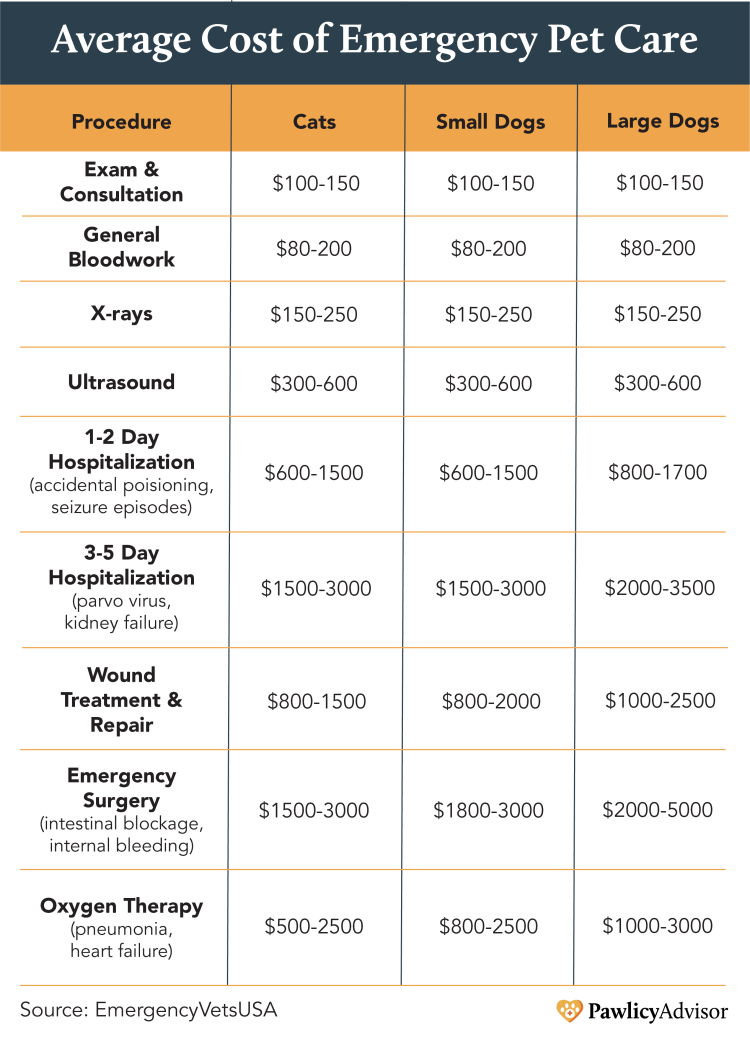
Although prices vary depending on the size of your animal, where you live, and the time of treatment, many pet parents find it difficult to afford unexpected emergency vet bills, leaving them under financial stress during an already stressful situation. In these circumstances, pet insurance can provide valuable peace of mind by reimbursing up to 100% of covered vet visit costs paid for out of pocket (once the policy deductible is met). This ensures pets have access to gold-standard care while reducing the financial burden on owners and enabling them to focus on their loved ones, rather than the cost of care in a cat or dog ER.
Pet wellness plans can also cover routine exams in which your veterinarian will screen for possible health conditions. Early detection of disease can help prevent a severe manifestation of symptoms that could cause a life-threatening emergency if left undetected. Together, you and your vet can create a healthcare plan that manages the clinical signs of illness, promotes optimal health, and helps you avoid sudden pet emergencies through proactive care.
Key Takeaways
- Having a sick or injured pet is stressful, but you may not have to rush to a pet emergency room.
- Knowing the signs of common life-threatening emergencies can help you to make the best possible decision for when to seek care for your pet.
- If you aren’t sure if your pet is experiencing a medical emergency, call your regular veterinarian or a local emergency clinic for advice.
- Don’t forget to purchase pet insurance for your pet to help cover the costs of illness or injury, especially if emergency medical care is required.
Do you want to find the best pet insurance?
Let's analyze your pet's breed, age, and location to find the right coverage and the best savings. Ready?
About Pawlicy Advisor
The pet insurance marketplace endorsed by veterinarians, at Pawlicy Advisor we make buying the best pet insurance easier. By comparing personalized coverage and pricing differences we can save you a ton of money, up to 83% in some instances!

Instantly Compare Pet Insurance Plans
How To Compare Plans
Determine If Pet Insurance Is Worth It
Determine If Wellness Plans Are Worth It
Vet Visit Costs
New Puppy Checklist
Comparison Charts
ASPCA vs. Pets Best
Pets Best vs. Embrace
Embrace vs. Pumpkin
Pumpkin vs. MetLife
More Comparison Charts
Find Your State
Pennsylvania
More States
Dog Insurance
German Shepherd
English Bulldog
French Bulldog
More Breeds
.css-3sl4ml{color:#E26C33;-webkit-text-decoration:none;text-decoration:none;}.css-3sl4ml:hover{color:#E26C33;-webkit-text-decoration:underline;text-decoration:underline;} Dr. Kate Boatright .css-aqd080{font-size:16px;font-weight:bold;}@media screen and (min-width: 992px){.css-aqd080{font-size:21px;}} Associate Veterinarian, Speaker, Author - Penn-Ohio Veterinary Services and KMB Veterinary Media LLC
Dr. Kate Boatright, VMD, works as a small animal general practitioner, freelance speaker, and author in western Pennsylvania. Since graduating from the University of Pennsylvania with her veterinary degree in 2013, she has worked throughout Pennsylvania as both a general practice and emergency veterinarian. Both in the clinic and outside of it, Dr. Boatright enjoys building relationships with her clients and educating pet owners on how they can keep their pets as healthy as possible. She loves being a veterinarian and educating students and colleagues on wellness, communication, and the unique challenges facing recent graduates. Outside of the clinic, she is active in many veterinary organizations, enjoys running, watching movies, and playing games with her husband, son, and cats.
More you might like

Top 10 Items To Put In A Dog First Aid Kit

What Fruits Can Dogs Eat?

Can Cats Drink Milk?

Can Cats Eat Bananas?

Human Foods Cats Can and Can't Eat

Why Is My Dog Eating Grass?

Can Cats Eat Apples?

Can Cats Eat Corn?
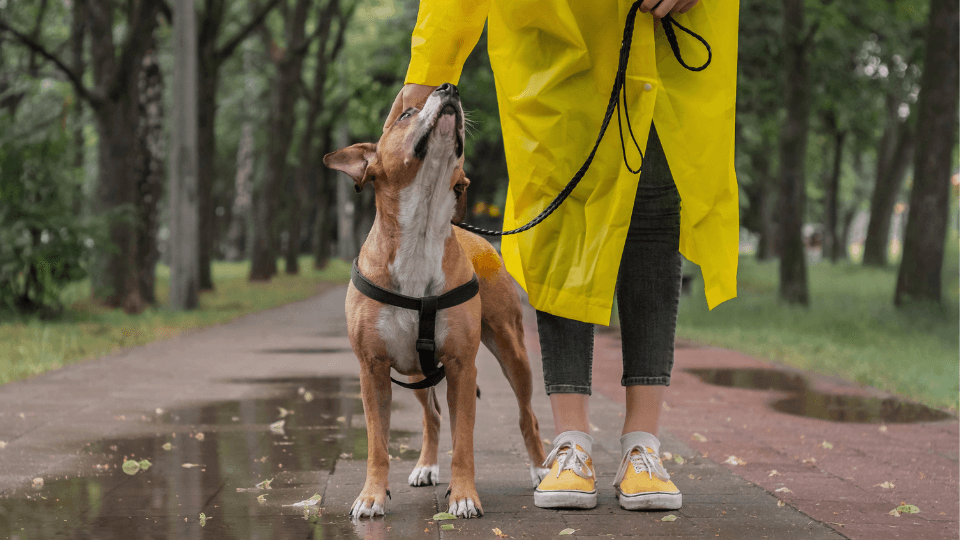
Pet Emergency Kit Checklist

Can Cats Eat Avocado?

Can Cats Eat Carrots?

Can Cats Eat Cheese? Here’s Everything You Need to Know

Blastomycosis in Dogs: Symptoms, Treatment & Prevention

10 Inspiring Photos of Heroic Dogs Caught in the Act

10 Photos of Cats Being Household Heroes

Can Cats Eat Rice?

Cat Health Issues

Diarrhea in Dogs: Causes, Treatments, Prevention

10 Heartwarming Photos of Mamma Cats & Their Kittens

10 Adorable Pics of Mamma Dogs & Their Puppies

Cat Cats Eat Grapes?

Mastitis In Dogs: Symptoms, Causes, & Treatment
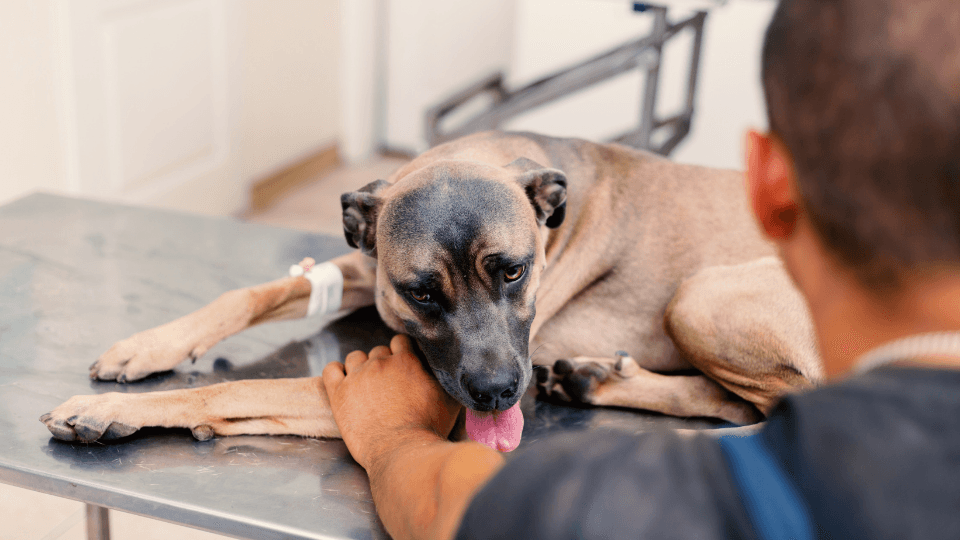
Osteosarcoma (Bone Cancer) in Dogs: Causes, Symptoms, Treatment

List of Food Dogs Can (and Can't) Eat, According to Vet

Can Dogs Eat Garlic? Here's Everything You Need to Know

Ataxia in Dogs: Causes, Symptoms, and Treatment

Conjunctivitis (Pink Eye) in Dogs: Causes, Symptoms, Treatment

Tapeworms in Cats: Causes, Symptoms, Treatment

Labrador Retriever Growth & Weight Chart: Everything You Need To Know

Basset Hound Growth & Weight Chart: Everything You Need to Know

Havanese Growth & Weight Chart: Everything You Need to Know

Maltese Growth & Weight Chart: Everything You Need To Know

Pomeranian Growth & Weight Chart: Everything You Need to Know

Dachshund Growth & Weight Chart: Everything You Need To Know

Greyhound Growth & Weight Chart: Everything You Need to Know

Jack Russell Terrier Growth & Weight Chart: Everything You Need to Know

Newfoundland Growth & Weight Chart: Everything You Need to Know

Bernese Mountain Dog Growth & Weight Chart: Everything You Need to Know

Siberian Husky Growth & Weight Chart: Must-Know Health Facts
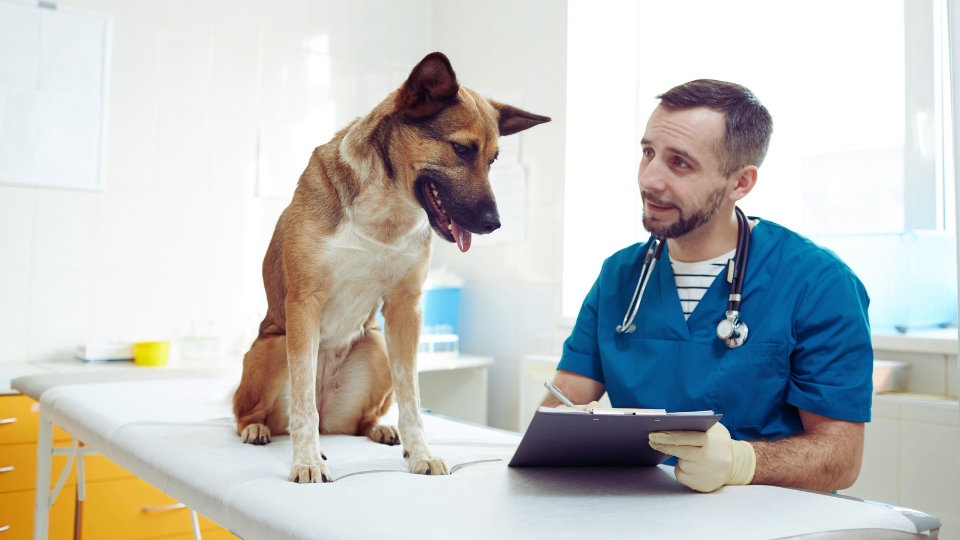
Dog Health Issues: Common Conditions by Breed, Size, Age
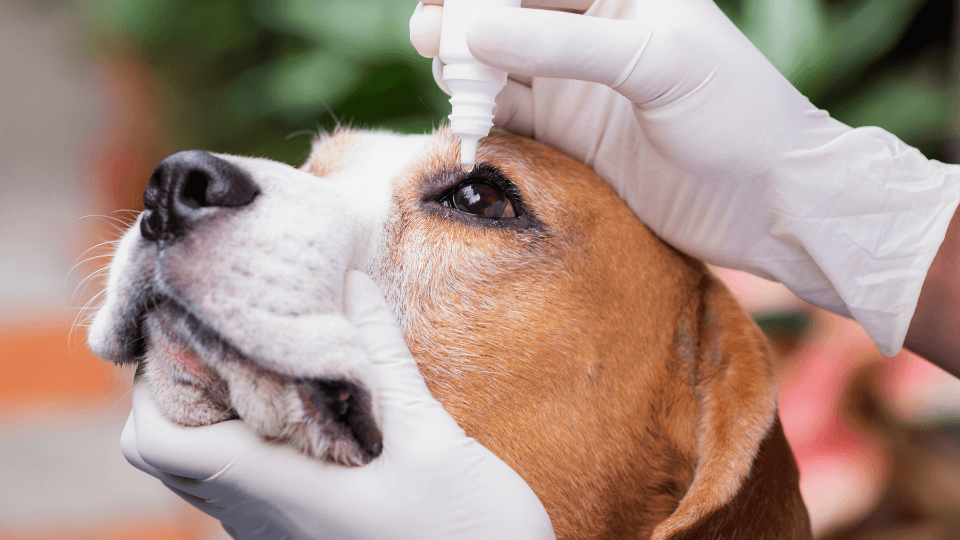
Glaucoma in Dogs: Causes, Symptoms & Treatment

Can Dogs Drink Milk? Here's Everything You Need to Know

Can Dogs Eat Coconut? Here's Everything You Need to Know

Can Dogs Eat Tuna? Here's Everything You Need to Know

Labradoodle Growth & Weight Chart: Everything You Need to Know

Saint Bernard Growth & Weight Chart: Everything You Need to Know

Pit Bull Growth & Weight Chart: Everything You Need to Know

Colitis in Dogs: Symptoms, Diagnosis, Treatment

Glucosamine For Dogs: Uses, Dosage & Side Effects

Hypothyroidism in Dogs: Causes, Symptoms, Treatments

How Much Does a Vet Visit Cost? (2024)
The average cost of a routine vet checkup can range from $50 to $250, but the total cost varies based on the purpose of the visit..
7+ years writing insurance and personal finance content
Contributor to top media, including USA Today
A passionate personal finance advocate, Sarah’s writing has graced the pages of many of the personal finance and insurance industries’ top web publications.
Read Editorial Guidelines
Featured in
)
Licensed auto and home insurance agent
4+ years in content creation and marketing
As Insurify’s home and pet insurance editor, Danny also specializes in auto insurance. His goal is to help consumers navigate the complex world of insurance buying.
Updated November 6, 2023 | Reading time: 4 minutes
)
At Insurify, our goal is to help customers compare insurance products and find the best policy for them. We strive to provide open, honest, and unbiased information about the insurance products and services we review. Our hard-working team of data analysts, insurance experts, insurance agents, editors and writers, has put in thousands of hours of research to create the content found on our site.
We do receive compensation when a sale or referral occurs from many of the insurance providers and marketing partners on our site. That may impact which products we display and where they appear on our site. But it does not influence our meticulously researched editorial content, what we write about, or any reviews or recommendations we may make. We do not guarantee favorable reviews or any coverage at all in exchange for compensation.
Table of contents
- Cost of a vet visit
- Common procedures
- Vaccinations for dogs
- Vaccinations for cats
- Emergency vet visits
- Coverage options
- Buying insurance
Table of contents Compare quotes
When you take your pet to the vet, the final bill might come as a surprise. While the cost of a vet visit varies based on the procedures and services your pet needs, veterinary care costs have increased sharply in recent years. [1]
A big reason for the higher costs is that demand for veterinary care is at an all-time high. Additionally, the costs of running a veterinary practice have risen, partially due to inflationary pressures. [1] In short, pet owners are facing a perfect storm with spiking vet bills as the end result.
Here’s what you should know about the costs you should expect to encounter if your pet needs to go to the veterinarian.
How much does a routine vet visit cost?
In general, dog owners face higher veterinary bills than cat owners. On average, the ASPCA estimates that dog owners pay $225 per year for routine medical costs, which include things like vaccines and wellness visits. In contrast, cat owners pay around $160 for routine medical care. [2]
As a pet owner, where you live can also affect your costs. For example, the estimated cost of an office visit at Banfield Pet Hospital is $78.95 in California, but that estimate drops to $57.95 in Florida. [3]
Costs of common veterinary procedures
Taking your pet to the vet for preventative care can help ensure it avoids health issues for years to come. But preventative care isn’t free. If you choose to invest in your pet’s health, you’ll likely face some or all of the following routine care costs. [4]
Cost of vaccinations for dogs
Vaccinations can help your pet stay healthy. In many cases, your vet will administer your dog’s vaccines during routine vet visits. The type and number of vaccines your dog needs can have a major effect on your final bill.
The table below highlights some common vaccinations your dog might receive and their costs. [4]
Cost of vaccinations for cats
Cat owners can help keep their companions healthy through vaccinations. Keeping your pet’s shots up to date often happens at the annual visit. The following table shows some common vaccinations your cat might need and the associated costs.
How much do emergency vet visits cost?
Regular checkups and routine care can help you protect your pet’s health. But even pets with the best care could end up in the emergency room. An emergency vet visit is often significantly more expensive than a routine visit. The exact costs of your emergency room visit will vary based on the treatments your pet needs. [4]
Below is a quick look at some potential medical costs for an emergency visit:
An ER exam could cost between $100 and $200.
A broken bone could cost $2,371 for dogs and $2,257 for cats.
A foreign object in your pet’s stomach could require veterinary care that runs $3,262 for dogs and $2,955 for cats.
Blood tests during an emergency vet visit could cost between $80 and $200.
An ultrasound at the vet could run between $300 and $600.
X-rays at the vet could cost between $150 and $250. [5]
If you have to head to the vet for emergency care, be prepared for a hefty vet bill.
How does pet insurance affect vet costs?
Pet insurance can help you cover the costs of a vet visit. Most pet insurance companies offer three basic types of coverage:
Accident and illness coverage: Accident and illness coverage can help you pay for things like broken bones and infections. This type of coverage typically doesn’t include medical expenses for hereditary conditions or routine care.
Accident-only coverage: Accident-only coverage is a more narrow form of insurance. It can help you pay for vet visits related to broken bones, cuts, bite wounds, and foreign body ingestion. But it won’t help pay for treating an illness, dental care, or basic vaccines.
Wellness coverage : In general, a wellness plan can help you pay for vaccines, preventative medicine, a physical exam, and additional costs for routine care.
If you choose to purchase pet insurance, your insurance company will likely have a reimbursement policy. You’ll typically submit a claim for your vet bill after your vet visit, and if the company approves the claim, you’ll receive the agreed-upon percentage of the vet bill.
Pet insurance can be a good idea for the right household, but it’s important to run the numbers before deciding to move forward.
Factors to consider when buying pet insurance
If you’re interested in purchasing pet insurance, it’s important to consider all the details before signing up for a policy. Below are some factors to keep in mind:
Shopping around
Every insurance company has a slightly different method of determining premiums. Because of that, shopping around can help you find the best policy .
Reimbursements
Most pet insurance companies cover your vet bills through a reimbursement policy. You’ll need to pay the bill up front. When you submit a claim, you’ll receive a reimbursement for an agreed-upon percentage of the bill.
Payout limits
Some pet insurance policies have annual or lifetime payout limits.
Deductibles
The deductible is the minimum amount you’ll need to pay for a covered vet visit. Make sure it’s a number you can comfortably afford.
Coverage type
The type of coverage you purchase will greatly affect what kind of vet bills your policy will cover. Read the fine print to understand what’s covered.
Puppies are often cheaper to insure than older pets. However, older pets are more likely to need vet care due to age-related health problems. Weigh the policy costs against the potential veterinary costs.
Vet cost FAQs
Vet costs can be a significant expense for pet owners across the country. With rising costs, it’s natural to have questions. The answers below may help as you decide whether to enroll your pet in a pet insurance plan.
On average, pet owners can expect to pay between $50 and $250 for a routine visit. However, the final bill will vary based on the type of care your pet needs.
Why do vets charge so much?
The cost of veterinary care has risen sharply in the last five years. A core reason for higher costs is that veterinary practices are facing inflationary pressure, which means they must charge more for their services. Additionally, the demand for pet care is high, which also pushes costs higher.
Do vet offices offer payment plans?
Some vets offer payment plans to pet owners. If you need a payment plan option, ask your vet to see what’s available.
Is pet insurance worth it?
If you don’t have a robust emergency fund to cover unexpected veterinary care, pet insurance might be worth the price. But even households with savings might benefit from a pet insurance plan. You should consider your pet’s health and your financial situation to determine if the premiums are worth the coverage.
- National Library of Medicine . " Blame the pandemic: Why you need to raise your fees for 2021 ."
- American Society for the Prevention of Cruelty to Animals . " Cutting Pet Care Costs ."
- Banfield Pet Hospital . " Price Estimator ."
- Care Credit . " Average Vet Visit Costs for Pets ."
- Preventive Vet . " Pet Emergency Statistics and Veterinary Costs ."
Sarah Sharkey is a personal finance writer who enjoys helping people make savvy financial decisions. She covered insurance and personal finance topics. You can find her work on Business Insider, Money Under 30, Rocket Mortgage, Bankrate, and more. Connect with her on LinkedIn .
- Skip to main content
- Keyboard shortcuts for audio player
Morning Edition
- Latest Show
- About The Program
- Contact The Program
- Corrections
Listen to the featured story from this episode.

Álvaro Enciso places crosses at sites where migrants are known to have died in the borderland, this cross represents the death of Nolberto Torres-Zayas just east of Arivaca, Arizona on Wednesday, March 27, 2024. Torres-Zayas died of hyperthermia in 2009, not far from a Humane Borders water cache that had been vandalized and drained. Ash Ponders for NPR hide caption
We, The Voters
Is it easy for migrants to enter the u.s. we went to the border to find out.
Morning Edition spoke to migrants hoping to enter the U.S. and the border agents tasked with keeping them out.
Middle East
Morning news brief.
by Michel Martin , Steve Inskeep
Author Interviews
'washington post' columnist david ignatius releases 12th novel: 'phantom orbit'.

Ammer Qudummi was arrested at a UT Austin protest on April 26, but all charges have been dropped. Michael Minasi/KUT hide caption
Campus protests over the Gaza war
How these university of texas-austin students view gaza war protests on their campus.
by Mansee Khurana
Why more than 1,000 sea lions are lounging at Pier 39 in San Francisco

Republican Sen. Bill Hagerty of Tennessee speaks about the Senate version of the Equal Representation Act during a January press conference in Washington, D.C. The bill is one of at least a dozen GOP proposals to exclude some or all non-U.S. citizens from a special census count that the 14th Amendment says must include the "whole number of persons in each state." Mariam Zuhaib/AP hide caption
Republicans in Congress are trying to reshape election maps by excluding noncitizens
by Hansi Lo Wang

Miguel Divo shows his patient, Joel Rubinstein, a dry powder inhaler. It's an alternative to some puff inhalers that emit potent greenhouse gases, but is equally effective for many patients with asthma. Jesse Costa/WBUR hide caption
Shots - Health News
Could better asthma inhalers help patients, and the planet too.
by Martha Bebinger
Internet connectivity — even in 2024 — is vulnerable at a number of levels
by Jenna McLaughlin

by Steve Inskeep , Ally Schweitzer
After some setbacks, Boeing prepares for Starliner's first crewed launch into space
by Steve Inskeep , Brendan Bryrne
Week 4 of the Trump hush money case is about to get underway
by Michel Martin , Ximena Bustillo
China's President Xi Jinping begins a 5-day tour in Europe
by Steve Inskeep , Eleanor Beardsley
Woman denies being an 'outside agitator' in Columbia University protests
Madonna just gave the biggest live performance of her career, lou reed issued one of the most puzzling albums in rock history in 1975.
by Phil Harrell
GOP effort started by Rep. Marjorie Taylor Green will try to oust Speaker Johnson
Cease-fire negotiations between israel and hamas appear to have broken down.
by Steve Inskeep , Lauren Frayer

Women no longer have to make the first move on Bumble, the dating app that was launched in 2014 with the goal of putting more power in the hands of women. Nikos Pekiaridis/Getty Images hide caption
Women no longer have to make the first move on Bumble. Will it make the app better?
by Claire Murashima
Searching for a song you heard between stories? We've retired music buttons on these pages. Learn more here.
- Best Extended Auto Warranty
- Best Used Car Warranty
- Best Car Warranty Companies
- CarShield Reviews
- Best Auto Loan Rates
- Average Auto Loan Interest Rates
- Best Auto Refinance Rates
- Bad Credit Auto Loans
- Best Auto Shipping Companies
- How To Ship a Car
- Car Shipping Cost Calculator
- Montway Auto Transport Reviews
- Best Car Buying Apps
- Best Websites To Sell Your Car Online
- CarMax Review
- Carvana Reviews
- Best LLC Service
- Best Registered Agent Service
- Best Trademark Service
- Best Online Legal Services
- Best CRMs for Small Business
- Best CRM Software
- Best CRM for Real Estate
- Best Marketing CRM
- Best CRM for Sales
- Best Free Time Tracking Apps
- Best HR Software
- Best Payroll Services
- Best HR Outsourcing Services
- Best HRIS Software
- Best Project Management Software
- Best Construction Project Management Software
- Best Task Management Software
- Free Project Management Software
- Best Personal Loans
- Best Fast Personal Loans
- Best Debt Consolidation Loans
- Best Loans for Bad Credit
- Best Personal Loans for Fair Credit
- HOME EQUITY
- Best Home Equity Loan Rates
- Best Home Equity Loans
- Best Checking Accounts
- Best Free Checking Accounts
- Best Online Checking Accounts
- Best Online Banks
- Bank Account Bonuses
- Best High-Yield Savings Accounts
- Best Savings Accounts
- Average Savings Account Interest Rate
- Money Market Accounts
- Best CD Rates
- Best 3-Month CD Rates
- Best 6-Month CD Rates
- Best 1-Year CD Rates
- Best 5-Year CD Rates
- Best Jumbo CD Rates of April 2024
- Best Hearing Aids
- Best OTC Hearing Aids
- Most Affordable Hearing Aids
- Eargo Hearing Aids Review
- Best Medical Alert Systems
- Best Medical Alert Watches
- Best Medical Alert Necklaces
- Are Medical Alert Systems Covered by Insurance?
- Best Online Therapy
- Best Online Therapy Platforms That Take Insurance
- Best Online Psychiatrist Platforms
- BetterHelp Review
- Best Mattress
- Best Mattress for Side Sleepers
- Best Mattress for Back Pain
- Best Adjustable Beds
- Best Home Warranty Companies
- American Home Shield Review
- First American Home Warranty Review
- Best Home Appliance Insurance
- Best Moving Companies
- Best Interstate Moving Companies
- Best Long-Distance Moving Companies
- Cheap Moving Companies
- Best Window Replacement Companies
- Best Gutter Guards
- Gutter Installation Costs
- Best Window Brands
- Best Solar Companies
- Best Solar Panels
- How Much Do Solar Panels Cost?
- Solar Calculator
- Best Car Insurance Companies
- Cheapest Car Insurance Companies
- Best Car Insurance for New Drivers
- Same-day Car Insurance
- Best Pet Insurance
- Pet Insurance Cost
- Cheapest Pet Insurance
- Pet Wellness Plans
- Best Life Insurance
- Best Term Life Insurance
- Best Whole Life Insurance
- Term vs. Whole Life Insurance
- Best Travel Insurance Companies
- Best Homeowners Insurance Companies
- Best Renters Insurance Companies
- Best Motorcycle Insurance
Partner content: This content was created by a business partner of Dow Jones, independent of the MarketWatch newsroom. Links in this article may result in us earning a commission. Learn More
How Much Does Pet Insurance Cost? (May 2024)

Faith Wakefield is a writer based in North Carolina. She holds economics and English degrees from UNC Chapel Hill, and her work has been featured on EcoWatch, The World Economic Forum and Today’s Homeowner. In her free time, she loves to binge-watch personal finance videos on YouTube, collect books and spend time in nature.

Sabrina Lopez is an editor with over six years of experience writing and editing digital content with a particular focus on home services, home products and personal finance. When she is not working on articles to help consumers make informed decisions, Sabrina enjoys creative writing and spending time with her family and their two parrots.

Dr. Patrik Holmboe completed his veterinary studies at the University of Melbourne in 2015 and spent over five years working as a companion-animal vet in Australia, Dubai, and the Netherlands. In 2021, he merged his interests in veterinary medicine, technology and innovation by joining Cooper Pet Care, the leading veterinary telemedicine provider in the Netherlands. In his role as Head Veterinarian, he oversees all veterinary operations, focusing on elevating client experience.
We found that, on average, pet insurance costs $66 a month for dogs and $32 a month for cats. However, pet insurance premiums typically range from $15 to $90 a month .
Pet insurance is an affordable alternative to paying vet bills out of pocket and can offer financial protection against high-cost emergency vet visits.

5,534 pet owners requested and received a free no-obligation quote from one of the above companies in the last 30 days.
How Much Does Pet Insurance Cost?
According to our research, pet insurance costs $768 a year for dogs and $324 a year for cats, with an overall average monthly cost landing at $49 per month. Our team secret-shopped for 14 national pet insurance providers and gathered over 2,000 quotes in all 50 states.
Use the table below to find out what the average cost for pet insurance in your state is:
This information is based on different provider quotes collected for an accident-and-illness policy for a 5-year-old medium mixed-breed male dog, a 2-year-old female golden retriever, a 5-year-old mixed-breed male cat and a 2-year-old female Siamese cat in all 50 states. A total of 200 quotes averaged per provider for each species type.
Why Trust Us?
Compare pet insurance costs.
You will also find that the provider you choose impacts the price you pay, even when your pet and coverage details remain constant. Compare costs between the best pet insurance providers:
Unfortunately, when it comes to the cost of pet insurance for your furry one, there is no one-size-fits-all average cost that we can provide. The exact cost of your pet insurance premium will depend on a variety of factors, including:
- Previous health conditions
The cost of the plan you pick will also be impacted by the provider and type of coverage you choose. Like health insurance for humans, there is no right or wrong coverage option, just a right pet insurance plan that works for you.
While we can't tell you what you will pay, we can tell you more about industry averages and what we've seen from pet insurance providers, real customers, and our secret shoppers.
How Much Does Pet Insurance for Dogs Cost?
According to our comparison of the top 10 best pet insurance providers, pet insurance for dogs costs $66 per month for adult dogs and $53 per month for puppies .
Pet Insurance Cost by Dog Breed
You can compare the average monthly costs of insuring popular dog breeds with the chart below.
As you can see in the table, the price of coverage for your pet increases as they get older. You may see only a modest increase each year until your dog turns about six, when the coverage cost may escalate more quickly.
Pet Insurance Cost for Dogs by Provider
ManyPets and Lemonade are, on average, the cheapest pet insurance plans for dogs. Compare the monthly rates of top providers below:
How Much Is Pet Insurance for Cats?
The average cost of pet insurance for cats is $32 per month for adult cats and $25 per month for kittens. The exact cost of cat insurance will depend on the cat’s breed and age and where you live.
Cat Insurance Cost by Cat Breed
As you can see in the chart below, the cost of accident and illness coverage for cats can vary dramatically depending on your pet’s breed and age.
Cat Insurance Cost by Provider
Based on our review, Many Pets and Lemonade are the cheapest pet insurance plans for cats. Compare the average monthly rates of top providers below:
What Affects Pet Insurance Costs?
Your pet’s age , breed and location, and the chosen coverage options and discounts will all impact the overall cost of insuring your pet.
Coverage Options
Most pet insurance providers allow you to customize your annual limit , deductible and reimbursement rate. You will generally pay the lowest monthly premium if you choose a low annual limit, low reimbursement percentage and high deductible. However, you will pay more out of pocket when your pet goes to the vet.
Breeds with a higher risk of certain health conditions will cost more to insure each month. Purebred pets can be predisposed to illnesses that can make veterinary care more expensive, driving up the price of a pet insurance policy .
The cost of covering older pets will always be more expensive than a younger ones, but each provider has different policies about when and how it raises premiums.
Most pet insurance companies allow you to enroll your pet at 6 weeks old. Some companies have a maximum age limit for enrollment, often ranging from 10 to 14 years. Therefore, if you have an older dog or cat, you’ll need to find a company for senior pets that does not have upper age limits.
When should you enroll your pet in a plan?
Patrik Holmboe, Head Veterinarian at Cooper Pet Care , suggested,
“Overall, the best time to enroll your pet in pet insurance is when they are young and healthy. Basically, the sooner, the better!”
Most pet insurance companies do not cover preexisting conditions , and their chance of developing them increases as they age. Holmboe added,
“Most policies are cheaper for younger pets. If you start early, most insurance policies allow you to either lock in this lower price or gain some form of discount as the animal ages.”
Where You Live
Your location also plays a role in the price you will pay for any type of insurance coverage — not just pet insurance. Different states have different laws and regulations that dictate insurance pricing, what data a company can collect from consumers and what benefits providers must include with coverage. For example, while most states allow insurance providers to collect credit score information to determine rates for things like homeowners and auto insurance, California and Hawaii forbid insurers from collecting this information.
As a result of variations in state law, insurance companies take on different levels of risk depending on the policyholder’s residence. Pet insurance is no exception — in our review, we found significant variance in coverage rates between states. For example, the average monthly cost of pet insurance in Missouri is $41 , while the state average in Massachusetts is $75 per month . Overall, the most expensive states to insure your pet in are Massachusetts, Connecticut and California , while the most affordable are Arkansas, Nevada and North Dakota .
Provider Chosen
The provider itself impacts the premium you pay. Each company assesses risk a little bit differently, weighing some factors more than others. That can lead to varying costs for identical policies based on the provider you choose. Based on our analysis, Lemonade offers great value by combining affordable prices with comprehensive coverage.
Discounts Offered
Many providers offer discounts when you enroll multiple pets or pay for your annual coverage upfront. Additionally, some providers offer discounts for policyholders who are military members or animal care workers. Compare top companies’ discounts below.
How Does Pet Insurance Work?
Once you enroll in pet insurance, your coverage will begin after the waiting period . Depending on your provider, the waiting period is typically between two days and two weeks . Remember, the treatment will not be eligible for coverage if your pet is injured or ill during the waiting period .
After the waiting period ends, you can take your pet to any licensed veterinarian for treatment. You’ll pay the vet, submit a claim and later get reimbursed from your provider.
How much your pet insurance provider will reimburse you depends on your chosen reimbursement rate . In general, the higher your reimbursement level , the higher your monthly premium will be.
Do All Veterinarians Accept Pet Insurance?
Yes, you can go to any veterinarian when you have pet insurance . Typically, you will pay your full vet bill upfront and file a claim to your insurance company for reimbursement. Once your pet insurance provider approves your claim, you will be reimbursed for your vet visit . The percentage of total expenses your provider will cover depends on your plan options.
If you want to avoid filing a claim and waiting for reimbursement, some providers like Trupanion and Pets Best partner with vets to automatically process your reimbursement, so you don't have to pay the whole bill upfront. This sometimes limits which vets you can go to, as it requires that the clinic be partnered with the insurance provider.
What Does Pet Insurance Cover?
Every pet insurance provider offers slightly different plans. However, the most common accident and illness policies cover the following:
- Accidents and injuries ( broken bones , toxic ingestions, bite wounds, etc.)
- Diagnostic testing (MRIs, X-rays , CAT scans, bloodwork , etc.)
- Major and minor illnesses ( cancer , epilepsy, allergies, ear infections, etc.)
- Prescription medication
- Surgical procedures
Most pet insurance providers also offer an optional wellness add-on covering preventative care costs like checkups, behavioral therapy , vaccinations , spaying/neutering , exam fees, microchipping and more.
What Is Not Covered by Pet Insurance?
What is not covered by pet insurance also varies slightly by provider . However, most providers have the following exclusions :
- Preexisting conditions , including any illness or health issue your pet had before enrollment in coverage
- Illnesses or injuries that came about during your plan’s waiting period
- Preventative care (unless explicitly covered or you enroll in a wellness add-on plan )
- Cosmetic procedures
- Elective procedures
- Pregnancy/breeding
- Grooming
Some pet insurance companies, like Embrace , will cover a curable preexisting condition after a specific waiting period as long as the symptoms are not recurring.

What’s the Best Pet Insurance for Your Budget?
Multiple pet insurance providers operate nationwide, and you can find the best plan for your pet and your budget by researching several different companies. Compare the coverage options and services offered by each insurer, keeping in mind that the cheapest plan may not be the best plan if it does not provide the coverage your pet needs.
We recommend L emonade, Spot and Fetch Pet Insurance as top providers that offer affordable yet comprehensive accident and injury plans. Many providers offer wellness add-ons to cover routine preventive care, such as wellness visits, vaccines, parasite prevention, and spay or neuter surgery .
Lemonade is our overall top choice for affordable pet insurance because it offers lower-than-average monthly premiums with customizable options that allow you to build a plan that works best for your budget. Lemonade also offers a 10% discount if you bundle pet insurance with a homeowners or renters policy, which can lower your premium even more.
Cheap Pet Insurance Plans Cost
The cheapest pet insurance company is ManyPets , with an average policy cost of $23.06 per month, but Lemonade comes in at a close second at $23.18 per month. On the higher end, Trupanion Pet Insurance has an average cost of $88.13 per month.
The table below ranks the top 5 most affordable pet insurance companies, based on our analysis:
Is Pet Insurance Worth It?
Many pet parents feel that pet insurance is worth it, but it may not be the right choice for everyone. Becky Simmonds, professional dog trainer and behaviorist at Breed Advisor , suggested that pet insurance may be a good option if:
- You’re uncertain you’d be able to pay for unexpected vet costs
- Having insurance would give you peace of mind
- You have a dog or cat breed prone to certain genetic health problems like hip dysplasia or cancer
Everyone’s circumstances are different, so weigh the costs and benefits of enrolling in a pet insurance plan for yourself. If you own a high-risk dog breed or live in an area where veterinarian health care is expensive, pet insurance may be a great option.
Vet Visit Costs
According to our analysis, the average cost of an emergency vet visit is anywhere from $374 to $1,285. However, surgeries and hospitalizations will cost much more.
Average Costs of Pet Medical Treatments
The out-of-pocket cost for pet medical care can rack up quickly: Serious procedures or treatments like ACL surgery, chemotherapy and foreign object removal can cost thousands of dollars. But even treatments for common ailments like diarrhea or ear infections can cost hundreds.
Frequently Asked Questions About Pet Insurance Cost
Which pet insurance provider is the cheapest.
According to our comparison of the top 10 pet insurance providers , we found that, on average, ManyPets and Pets Best offer the cheapest plans for cats and dogs.
What are the pros and cons of pet insurance?
Pet insurance gives pet owners peace of mind and financial security, knowing they won’t have to pay a very high vet bill when their pet has an unexpected injury or illness. However, pet insurance can be expensive depending on your chosen plan and provider . Additionally, if your insurance provider does not pay your vet directly, you’ll still have to pay the full vet bill and wait for a reimbursement .
Does pet insurance cover dental care?
Most pet insurance providers will cover dental accidents and illnesses but not routine dental care. Some providers , like Lemonade , require you to select an add-on to cover most dental treatments.
Does pet insurance cover routine care?
Most cat and dog insurance plans only cover the cost of accidents. illnesses and hospitalization , not routine care . However, most insurance providers offer an optional wellness plan that extends coverage to include preventative and routine care like checkups and vaccinations.
According to our review of the top 10 pet insurance providers, we found that, on average, Lemonade and Embrace offer the cheapest plans for cats and dogs.
How We Gathered Cost Data
Our team reviewed pet insurance companies in-depth to provide the most accurate and up-to-date pricing information available. While pet insurance pricing will vary based on your pet’s personal details, we took the following steps when collecting data to get a full scope of industry pricing.
- Overall cost averages: We pulled individual quotes from each of our recommended pet insurance providers for every state, using individual pet age, breed and other data points as indicated. After pulling hundreds of quotes encompassing the entire U.S., we removed major outliers to create an inclusive and representative average.
- Cost data by provider: To determine cost data for each provider, we pulled sample quotes with similar criteria for a fair comparison between companies. We also pulled quotes using the same pet data from multiple states and then averaged all costs together for four breeds.
- Cost data by breed: We evaluated cost data for 30 dog and cat breeds. To gather this information, we averaged quotes for each breed from five providers via PetInsurer.
- Cost data by age: We looked at pet insurance quotes for younger cats and dogs, adult pets and senior pets to compare cost changes as a pet ages. We collected breed- and provider-specific data for each age range and repeated our method of pulling individual price data from each state to get a comprehensive average.
We manually collected all cost information from each company’s respective website. Learn more about our review standards .
Methodology: Our System for Rating Pet Insurance Companies
We review each pet insurance company based on factors most important to pet parents like you. To inform our reviews, we surveyed 1,000 dog and cat owners nationwide to determine the most important elements of pet insurance coverage. Our process includes in-depth industry research about each provider, such as comparing coverage options, gathering quotes online to determine pricing and reading reviews to assess customer service.
We then score each provider on a 100-point scale and divide the final score by 20 to calculate an overall rating out of 5.0 stars. Here are more details about the factors we consider when reviewing pet insurance providers:
- Monthly pricing (25%): To assess pricing, we collected sample quotes for ten mixed-breed and purebred dogs and cats, ranging from 3 months old to 8 years old. Our team collected a total of 17,338 quotes directly from 22 provider's websites, obtaining at least two quotes for all 50 states from every provider for each pet profile. Providers earn the most points in this category for offering affordable coverage and a multi-pet discount.
- Plans (15%): The best pet insurance companies offer a range of plans to give customers the option to choose the coverage that is best for their pet. Companies offering accident and illness plans, accident-only plans, and wellness or preventive care add-ons earn full points in this category. We also look at coverage limits and award the most points for policies with unlimited coverage.
- Covered treatments (15%): According to our survey of pet owners, coverage is one of the most important factors when shopping for pet insurance. Companies with a breadth of included treatments and unique coverages receive more points in this category than providers with more standard or general policies.
- Customization options (10%): Customizing your pet insurance policy can help lower your cost. Providers that offer more annual limit, deductible and reimbursement rate options earn the highest scores in this category.
- Customer care (10%): Respondents to our survey also valued customer service when comparing pet insurance providers. We score each company based on its website accessibility and overall usability, customer service availability, mobile apps, money-back guarantees and veterinarian telehealth options, awarding points to insurers with more customer experience offerings.
- Industry reputation (10%): We review up-to-date ratings and accreditation information from the Better Business Bureau (BBB) and score companies based on years of industry experience and state availability.
- Waiting periods (10%): Companies with shorter accident, illness and orthopedic waiting periods between the time you sign up for coverage and your policy starts score higher in this category.
- Eligible age (5%): Some companies do not offer policies for pets over a certain age. For this category, we deduct points from providers that have age limits for covered pets.
We use our rating system to compare each company we review and determine the best pet insurance companies in the industry. To learn more, read our full pet insurance methodology for reviewing and scoring providers.
If you have questions about this page, please reach out to our editors at [email protected] .
More Resources in Pet Insurance

- Share full article
For more audio journalism and storytelling, download New York Times Audio , a new iOS app available for news subscribers.
A Plan to Remake the Middle East
While talks for a cease-fire between israel and hamas continue, another set of negotiations is happening behind the scenes..
This transcript was created using speech recognition software. While it has been reviewed by human transcribers, it may contain errors. Please review the episode audio before quoting from this transcript and email [email protected] with any questions.
From New York Times, I’m Michael Barbaro. This is The Daily.
[MUSIC CONTINUES]
Today, if and when Israel and Hamas reach a deal for a ceasefire fire, the United States will immediately turn to a different set of negotiations over a grand diplomatic bargain that it believes could rebuild Gaza and remake the Middle East. My colleague Michael Crowley has been reporting on that plan and explains why those involved in it believe they have so little time left to get it done.
It’s Wednesday, May 8.
Michael, I want to start with what feels like a pretty dizzying set of developments in this conflict over the past few days. Just walk us through them?
Well, over the weekend, there was an intense round of negotiations in an effort, backed by the United States, to reach a ceasefire in the Gaza war.
The latest ceasefire proposal would reportedly see as many as 33 Israeli hostages released in exchange for potentially hundreds of Palestinian prisoners.
US officials were very eager to get this deal.
Pressure for a ceasefire has been building ahead of a threatened Israeli assault on Rafah.
Because Israel has been threatening a military offensive in the Southern Palestinian city of Rafah, where a huge number of people are crowded.
Fleeing the violence to the North. And now they’re packed into Rafah. Exposed and vulnerable, they need to be protected.
And the US says it would be a humanitarian catastrophe on top of the emergency that’s already underway.
Breaking news this hour — very important breaking news. An official Hamas source has told The BBC that it does accept a proposal for a ceasefire deal in Gaza.
And for a few hours on Monday, it looked like there might have been a major breakthrough when Hamas put out a statement saying that it had accepted a negotiating proposal.
Israeli Prime Minister Benjamin Netanyahu says the ceasefire proposal does not meet his country’s requirements. But Netanyahu says he will send a delegation of mediators to continue those talks. Now, the terms —
But those hopes were dashed pretty quickly when the Israelis took a look at what Hamas was saying and said that it was not a proposal that they had agreed to. It had been modified.
And overnight —
Israeli troops stormed into Rafah. Video showing tanks crashing over a sign at the entrance of the city.
— the Israelis launched a partial invasion of Rafah.
It says Hamas used the area to launch a deadly attack on Israeli troops over the weekend.
And they have now secured a border crossing at the Southern end of Gaza and are conducting targeted strikes. This is not yet the full scale invasion that President Biden has adamantly warned Israel against undertaking, but it is an escalation by Israel.
So while all that drama might suggest that these talks are in big trouble, these talks are very much still alive and ongoing and there is still a possibility of a ceasefire deal.
And the reason that’s so important is not just to stop the fighting in Gaza and relieve the suffering there, but a ceasefire also opens the door to a grand diplomatic bargain, one that involves Israel and its Arab neighbors and the Palestinians, and would have very far-reaching implications.
And what is that grand bargain. Describe what you’re talking about?
Well, it’s incredibly ambitious. It would reshape Israel’s relationship with its Arab neighbors, principally Saudi Arabia. But it’s important to understand that this is a vision that has actually been around since well before October 7. This was a diplomatic project that President Biden had been investing in and negotiating actually in a very real and tangible way long before the Hamas attacks and the Gaza war.
And President Biden was looking to build on something that President Trump had done, which was a series of agreements that the Trump administration struck in which Israel and some of its Arab neighbors agreed to have normal diplomatic relations for the first time.
Right, they’re called the Abraham Accords.
That’s right. And, you know, Biden doesn’t like a lot of things, most things that Trump did. But he actually likes this, because the idea is that they contribute to stability and economic integration in the Middle East, the US likes Israel having friends and likes having a tight-knit alliance against Iran.
President Biden agrees with the Saudis and with the Israelis, that Iran is really the top threat to everybody here. So, how can you build on this? How can you expand it? Well, the next and biggest step would be normalizing relations between Israel and Saudi Arabia.
And the Saudis have made clear that they want to do this and that they’re ready to do this. They weren’t ready to do it in the Trump years. But Mohammed bin Salman, the Crown Prince of Saudi Arabia, has made clear he wants to do it now.
So this kind of triangular deal began to take shape before October 7, in which the US, Israel, and Saudi Arabia would enter this three way agreement in which everyone would get something that they wanted.
And just walk through what each side gets in this pre-October 7th version of these negotiations?
So for Israel, you get normalized ties with its most important Arab neighbor and really the country that sets the tone for the whole Muslim world, which is Saudi Arabia of course. It makes Israel feel safer and more secure. Again, it helps to build this alliance against Iran, which Israel considers its greatest threat, and it comes with benefits like economic ties and travel and tourism. And Prime Minister Benjamin Netanyahu has been very open, at least before October 7th, that this was his highest diplomatic and foreign policy priority.
For the Saudis, the rationale is similar when it comes to Israel. They think that it will bring stability. They like having a more explicitly close ally against Iran. There are economic and cultural benefits. Saudi Arabia is opening itself up in general, encouraging more tourism.
But I think that what’s most important to the Crown Prince, Mohammed bin Salman, is what he can get from the United States. And what he has been asking for are a couple of essential things. One is a security agreement whose details have always been a little bit vague, but I think essentially come down to reliable arms supplies from the United States that are not going to be cut off or paused on a whim, as he felt happened when President Biden stopped arms deliveries in 2021 because of how Saudi was conducting its war in Yemen. The Saudis were furious about that.
Saudi Arabia also wants to start a domestic nuclear power program. They are planning for a very long-term future, possibly a post-oil future. And they need help getting a nuclear program off the ground.
And they want that from the US?
And they want that from the US.
Now, those are big asks from the us. But from the perspective of President Biden, there are some really enticing things about this possible agreement. One is that it will hopefully produce more stability in the region. Again, the US likes having a tight-knit alliance against Iran.
The US also wants to have a strong relationship with Saudi Arabia. You know, despite the anger at Mohammed bin Salman over the murder of the Saudi dissident Jamal Khashoggi, the Biden administration recognizes that given the Saudis control over global oil production and their strategic importance in the Middle East, they need to have a good relationship with them. And the administration has been worried about the influence of China in the region and with the Saudis in particular.
So this is an opportunity for the US to draw the Saudis closer. Whatever our moral qualms might be about bin Salman and the Saudi government, this is an opportunity to bring the Saudis closer, which is something the Biden administration sees as a strategic benefit.
All three of these countries — big, disparate countries that normally don’t see eye-to-eye, this was a win-win-win on a military, economic, and strategic front.
That’s right. But there was one important actor in the region that did not see itself as winning, and that was the Palestinians.
[MUSIC PLAYING]
First, it’s important to understand that the Palestinians have always expected that the Arab countries in the Middle East would insist that Israel recognize a Palestinian state before those countries were willing to essentially make total peace and have normal relations with Israel.
So when the Abraham Accords happened in the Trump administration, the Palestinians felt like they’d been thrown under the bus because the Abraham Accords gave them virtually nothing. But the Palestinians did still hold out hope that Saudi Arabia would be their savior. And for years, Saudi Arabia has said that Israel must give the Palestinians a state if there’s going to be a normal relationship between Israel and Saudi Arabia.
Now the Palestinians see the Saudis in discussions with the US and Israel about a normalization agreement, and there appears to be very little on offer for the Palestinians. And they are feeling like they’re going to be left out in the cold here.
Right. And in the minds of the Palestinians, having already been essentially sold out by all their other Arab neighbors, the prospect that Saudi Arabia, of all countries, the most important Muslim Arab country in the region, would sell them out, had to be extremely painful.
It was a nightmare scenario for them. And in the minds of many analysts and US officials, this was a factor, one of many, in Hamas’s decision to stage the October 7th attacks.
Hamas, like other Palestinian leaders, was seeing the prospect that the Middle East was moving on and essentially, in their view, giving up on the Palestinian cause, and that Israel would be able to have friendly, normal relations with Arab countries around the region, and that it could continue with hardline policies toward the Palestinians and a refusal, as Prime Minister Benjamin Netanyahu has said publicly, to accept a Palestinian state.
Right. So Michael, once Hamas carries out the October 7th attacks in an effort to destroy a status quo that it thinks is leaving them less and less relevant, more and more hopeless, including potentially this prospect that Saudi Arabia is going to normalize relations with Israel, what happens to these pre-October 7th negotiations between the US, Saudi Arabia, and Israel?
Well, I think there was a snap assumption that these talks were dead and buried. That they couldn’t possibly survive a cataclysm like this.
But then something surprising happened. It became clear that all the parties were still determined to pull-off the normalization.
And most surprisingly of all, perhaps, was the continued eagerness of Saudi Arabia, which publicly was professing outrage over the Israeli response to the Hamas attacks, but privately was still very much engaged in these conversations and trying to move them forward.
And in fact, what has happened is that the scope of this effort has grown substantially. October 7th didn’t kill these talks. It actually made them bigger, more complicated, and some people would argue, more important than ever.
We’ll be right back.
Michael, walk us through what exactly happens to these three-way negotiations after October 7th that ends up making them, as you just said, more complicated and more important than ever?
Well, it’s more important than ever because of the incredible need in Gaza. And it’s going to take a deal like this and the approval of Saudi Arabia to unlock the kind of massive reconstruction project required to essentially rebuild Gaza from the rubble. Saudi Arabia and its Arab friends are also going to be instrumental in figuring out how Gaza is governed, and they might even provide troops to help secure it. None of those things are going to happen without a deal like this.
Fascinating.
But this is all much more complicated now because the price for a deal like this has gone up.
And by price, you mean?
What Israel would have to give up. [MUSIC PLAYING]
From Saudi Arabia’s perspective, you have an Arab population that is furious at Israel. It now feels like a really hard time to do a normalization deal with the Israelis. It was never going to be easy, but this is about as bad a time to do it as there has been in a generation at least. And I think that President Biden and the people around him understand that the status quo between Israel and the Palestinians is intolerable and it is going to lead to chaos and violence indefinitely.
So now you have two of the three parties to this agreement, the Saudis and the Americans, basically asking a new price after October 7th, and saying to the Israelis, if we’re going to do this deal, it has to not only do something for the Palestinians, it has to do something really big. You have to commit to the creation of a Palestinian state. Now, I’ll be specific and say that what you hear the Secretary of State, Antony Blinken, say is that the agreement has to include an irreversible time-bound path to a Palestinian state.
We don’t know exactly what that looks like, but it’s some kind of a firm commitment, the likes of which the world and certainly the Israelis have not made before.
Something that was very much not present in the pre-October 7th vision of this negotiation. So much so that, as we just talked about, the Palestinians were left feeling completely out in the cold and furious at it.
That’s right. There was no sign that people were thinking that ambitiously about the Palestinians in this deal before October 7th. And the Palestinians certainly felt like they weren’t going to get much out of it. And that has completely changed now.
So, Michael, once this big new dimension after October 7th, which is the insistence by Saudi Arabia and the US that there be a Palestinian state or a path to a Palestinian state, what is the reaction specifically from Israel, which is, of course, the third major party to this entire conversation?
Well, Israel, or at least its political leadership, hates it. You know, this is just an extremely tough sell in Israel. It would have been a tough sell before October 7th. It’s even harder now.
Prime Minister Benjamin Netanyahu is completely unrepentantly open in saying that there’s not going to be a Palestinian state on his watch. He won’t accept it. He says that it’s a strategic risk to his country. He says that it would, in effect, reward Hamas.
His argument is that terrorism has forced a conversation about statehood onto the table that wasn’t there before October 7th. Sure, it’s always in the background. It’s a perennial issue in global affairs, but it was not something certainly that the US and Israel’s Arab neighbors were actively pushing. Netanyahu also has — you know, he governs with the support of very right-wing members of a political coalition that he has cobbled together. And that coalition is quite likely to fall apart if he does embrace a Palestinian state or a path to a Palestinian state.
Now, he might be able to cobble together some sort of alternative, but it creates a political crisis for him.
And finally, you know, I think in any conversation about Israel, it’s worth bearing in mind something you hear from senior US officials these days, which is that although there is often finger pointing at Netanyahu and a desire to blame Netanyahu as this obstructionist who won’t agree to deals, what they say is Netanyahu is largely reflecting his population and the political establishment of his country, not just the right-wingers in his coalition who are clearly extremist.
But actually the prevailing views of the Israeli public. And the Israeli public and their political leaders across the spectrum right now with few exceptions, are not interested in talking about a Palestinian state when there are still dozens and dozens of Israeli hostages in tunnels beneath Gaza.
So it very much looks like this giant agreement that once seemed doable before October 7th might be more important to everyone involved than ever, given that it’s a plan for rebuilding Gaza and potentially preventing future October 7th’s from happening, but because of this higher price that Israel would have to pay, which is the acceptance of a Palestinian state, it seems from everything you’re saying, that this is more and more out of reach than ever before and hard to imagine happening in the immediate future. So if the people negotiating it are being honest, Michael, are they ready to acknowledge that it doesn’t look like this is going to happen?
Well, not quite yet. As time goes by, they certainly say it’s getting harder and harder, but they’re still trying, and they still think there’s a chance. But both the Saudis and the Biden administration understand that there’s very little time left to do this.
Well, what do you mean there’s very little time left? It would seem like time might benefit this negotiation in that it might give Israel distance from October 7th to think potentially differently about a Palestinian state?
Potentially. But Saudi Arabia wants to get this deal done in the Biden administration because Mohammed bin Salman has concluded this has to be done under a Democratic president.
Because Democrats in Congress are going to be very reluctant to approve a security agreement between the United States and Saudi Arabia.
It’s important to understand that if there is a security agreement, that’s something Congress is going to have to approve. And you’re just not going to get enough Democrats in Congress to support a deal with Saudi Arabia, who a lot of Democrats don’t like to begin with, because they see them as human rights abusers.
But if a Democratic president is asking them to do it, they’re much more likely to go along.
Right. So Saudi Arabia fears that if Biden loses and Trump is president, that those same Democrats would balk at this deal in a way that they wouldn’t if it were being negotiated under President Biden?
Exactly. Now, from President Biden’s perspective, politically, think about a president who’s running for re-election, who is presiding right now over chaos in the Middle East, who doesn’t seem to have good answers for the Israeli-Palestinian question, this is an opportunity for President Biden to deliver what could be at least what he would present as a diplomatic masterstroke that does multiple things at once, including creating a new pathway for Israel and the Palestinians to coexist, to break through the logjam, even as he is also improving Israel’s relations with Saudi Arabia.
So Biden and the Crown Prince hope that they can somehow persuade Bibi Netanyahu that in spite of all the reasons that he thinks this is a terrible idea, that this is a bet worth taking on Israel’s and the region’s long-term security and future?
That’s right. Now, no one has explained very clearly exactly how this is going to work, and it’s probably going to require artful diplomacy, possibly even a scenario where the Israelis would agree to something that maybe means one thing to them and means something else to other people. But Biden officials refuse to say that it’s hopeless and they refuse to essentially take Netanyahu’s preliminary no’s for an answer. And they still see some way that they can thread this incredibly narrow needle.
Michael, I’m curious about a constituency that we haven’t been talking about because they’re not at the table in these discussions that we are talking about here. And that would be Hamas. How does Hamas feel about the prospect of such a deal like this ever taking shape. Do they see it as any kind of a victory and vindication for what they did on October 7th?
So it’s hard to know exactly what Hamas’s leadership is thinking. I think they can feel two things. I think they can feel on the one hand, that they have established themselves as the champions of the Palestinian people who struck a blow against Israel and against a diplomatic process that was potentially going to leave the Palestinians out in the cold.
At the same time, Hamas has no interest in the kind of two-state solution that the US is trying to promote. They think Israel should be destroyed. They think the Palestinian state should cover the entire geography of what is now Israel, and they want to lead a state like that. And that’s not something that the US, Saudi Arabia, or anyone else is going to tolerate.
So what Hamas wants is to fight, to be the leader of the Palestinian people, and to destroy Israel. And they’re not interested in any sort of a peace process or statehood process.
It seems very clear from everything you’ve said here that neither Israel nor Hamas is ready to have the conversation about a grand bargain diplomatic program. And I wonder if that inevitably has any bearing on the ceasefire negotiations that are going on right now between the two of them that are supposed to bring this conflict to some sort of an end, even if it’s just temporary?
Because if, as you said, Michael, a ceasefire opens the door to this larger diplomatic solution, and these two players don’t necessarily want that larger diplomatic solution, doesn’t that inevitably impact their enthusiasm for even reaching a ceasefire?
Well, it certainly doesn’t help. You know, this is such a hellish problem. And of course, you first have the question of whether Israel and Hamas can make a deal on these immediate issues, including the hostages, Palestinian prisoners, and what the Israeli military is going to do, how long a ceasefire might last.
But on top of that, you have these much bigger diplomatic questions that are looming over them. And it’s not clear that either side is ready to turn and face those bigger questions.
So while for the Biden administration and for Saudi Arabia, this is a way out of this crisis, these larger diplomatic solutions, it’s not clear that it’s a conversation that the two parties that are actually at war here are prepared to start having.
Well, Michael, thank you very much. We appreciate it.
On Tuesday afternoon, under intense pressure from the US, delegations from Israel and Hamas arrived in Cairo to resume negotiations over a potential ceasefire. But in a statement, Israel’s Prime Minister Benjamin Netanyahu made clear that even with the talks underway, his government would, quote, “continue to wage war against Hamas.”
Here’s what else you need to know today. In a dramatic day of testimony, Stormy Daniels offered explicit details about an alleged sexual encounter with Donald Trump that ultimately led to the hush money payment at the center of his trial. Daniels testified that Trump answered the door in pajamas, that he told her not to worry that he was married, and that he did not use a condom when they had sex.
That prompted lawyers for Trump to seek a mistrial based on what they called prejudicial testimony. But the judge in the case rejected that request. And,
We’ve seen a ferocious surge of anti-Semitism in America and around the world.
In a speech on Tuesday honoring victims of the Holocaust, President Biden condemned what he said was the alarming rise of anti-Semitism in the United States after the October 7th attacks on Israel. And he expressed worry that too many Americans were already forgetting the horrors of that attack.
The Jewish community, I want you to know I see your fear, your hurt, and your pain. Let me reassure you, as your president, you’re not alone. You belong. You always have and you always will.
Today’s episode was produced by Nina Feldman, Clare Toeniskoetter, and Rikki Novetsky. It was edited by Liz O. Baylen, contains original music by Marion Lozano, Elisheba Ittoop, and Dan Powell, and was engineered by Alyssa Moxley. Our theme music is by Jim Brunberg and Ben Landsverk of Wonderly.
That’s it for The Daily. I’m Michael Barbaro. See you tomorrow.

- May 10, 2024 • 27:42 Stormy Daniels Takes the Stand
- May 9, 2024 • 34:42 One Strongman, One Billion Voters, and the Future of India
- May 8, 2024 • 28:28 A Plan to Remake the Middle East
- May 7, 2024 • 27:43 How Changing Ocean Temperatures Could Upend Life on Earth
- May 6, 2024 • 29:23 R.F.K. Jr.’s Battle to Get on the Ballot
- May 3, 2024 • 25:33 The Protesters and the President
- May 2, 2024 • 29:13 Biden Loosens Up on Weed
- May 1, 2024 • 35:16 The New Abortion Fight Before the Supreme Court
- April 30, 2024 • 27:40 The Secret Push That Could Ban TikTok
- April 29, 2024 • 47:53 Trump 2.0: What a Second Trump Presidency Would Bring
- April 26, 2024 • 21:50 Harvey Weinstein Conviction Thrown Out
- April 25, 2024 • 40:33 The Crackdown on Student Protesters
Hosted by Michael Barbaro
Featuring Michael Crowley
Produced by Nina Feldman , Clare Toeniskoetter and Rikki Novetsky
Edited by Liz O. Baylen
Original music by Marion Lozano , Elisheba Ittoop and Dan Powell
Engineered by Alyssa Moxley
Listen and follow The Daily Apple Podcasts | Spotify | Amazon Music | YouTube
If and when Israel and Hamas reach a deal for a cease-fire, the United States will immediately turn to a different set of negotiations over a grand diplomatic bargain that it believes could rebuild Gaza and remake the Middle East.
Michael Crowley, who covers the State Department and U.S. foreign policy for The Times, explains why those involved in this plan believe they have so little time left to get it done.
On today’s episode

Michael Crowley , a reporter covering the State Department and U.S. foreign policy for The New York Times.

Background reading :
Talks on a cease-fire in the Gaza war are once again at an uncertain stage .
Here’s how the push for a deal between Israel and Saudi Arabia looked before Oct. 7 .
From early in the war, President Biden has said that a lasting resolution requires a “real” Palestinian state .
Here’s what Israeli officials are discussing about postwar Gaza.
There are a lot of ways to listen to The Daily. Here’s how.
We aim to make transcripts available the next workday after an episode’s publication. You can find them at the top of the page.
The Daily is made by Rachel Quester, Lynsea Garrison, Clare Toeniskoetter, Paige Cowett, Michael Simon Johnson, Brad Fisher, Chris Wood, Jessica Cheung, Stella Tan, Alexandra Leigh Young, Lisa Chow, Eric Krupke, Marc Georges, Luke Vander Ploeg, M.J. Davis Lin, Dan Powell, Sydney Harper, Mike Benoist, Liz O. Baylen, Asthaa Chaturvedi, Rachelle Bonja, Diana Nguyen, Marion Lozano, Corey Schreppel, Rob Szypko, Elisheba Ittoop, Mooj Zadie, Patricia Willens, Rowan Niemisto, Jody Becker, Rikki Novetsky, John Ketchum, Nina Feldman, Will Reid, Carlos Prieto, Ben Calhoun, Susan Lee, Lexie Diao, Mary Wilson, Alex Stern, Dan Farrell, Sophia Lanman, Shannon Lin, Diane Wong, Devon Taylor, Alyssa Moxley, Summer Thomad, Olivia Natt, Daniel Ramirez and Brendan Klinkenberg.
Our theme music is by Jim Brunberg and Ben Landsverk of Wonderly. Special thanks to Sam Dolnick, Paula Szuchman, Lisa Tobin, Larissa Anderson, Julia Simon, Sofia Milan, Mahima Chablani, Elizabeth Davis-Moorer, Jeffrey Miranda, Renan Borelli, Maddy Masiello, Isabella Anderson and Nina Lassam.
Michael Crowley covers the State Department and U.S. foreign policy for The Times. He has reported from nearly three dozen countries and often travels with the secretary of state. More about Michael Crowley
Advertisement

IMAGES
COMMENTS
Getting your pet the help and care they need is going to be your priority. But this can come with some hefty bills. On average, an emergency exam costs $100-$200, and an overnight stay can cost $1,000-$2,000. And, this may or may not include diagnostic tests. To help make sure you're as prepared as possible, we've put together some ...
The average cost of an emergency vet could be anywhere from $250 to as much as $8,000. The following chart should help break down these costs. Procedure. Small Dogs. Large Dogs. Exam/Consultation ...
The cost also may vary based off of the size of your pet, as larger dogs will need more medications and fluids, thus making their ER visit cost more than the cost for a small dog or cat. The chart below provides a general breakdown of broad categories of diagnostics & treatments your pet may need at an emergency veterinary clinic.
Basic imaging (x-rays or ultrasound): $150-600. Hospitalization of 3 to 5 days: $2,000-3,500. Emergency surgery: $2,000-5,000. Depending on the illness or emergency, many pet owners end up with a ...
The actual cost depends on the gravity of the medical emergency as well as the tests and treatments your pet needs. Costs vary depending on the size, breed and type of pet as well. According to MetLife pet insurance, the cost of an emergency vet visit for a dog ranges from $150 to $5,000.
According to PetPlan pet insurance, the average cost of a veterinary emergency is $800 to $1,500. Keep in mind, however, that this is just an average. This estimate is also several years old, and veterinary costs (like other costs) have likely increased since the time this study was performed. Some emergency clinic visits, such as a ...
Always call ahead, and have a stand-by option ready if needed. Also be aware that an emergency visit will cost more than a regular office-hours visit, whether it's with your own vet or at a vet ...
The cost of your dog's visit can also vary according to the size of your pet (since most medications are weight-based) and any other complications. The cost can vary according to your geographic location as well. Procedure: Small Dogs: Large Dogs: Exam: $100-150: $100-150: Bloodwork: $80-200: $80-200: Radiographs: $150-250: $150-250:
Here's one thing you can count on: Emergency vet services cost more than routine vet services. The average cost for an examination by an emergency vet is $100-$150, roughly double the cost of exam fees at most general practitioners. The cost of procedures will be higher as well.
Quick Takeaways. From X-rays to emergency surgery, the cost of an emergency vet visit for your dog can range from $150 to $5,000, on average. Emergency vet visits for cats may cost between $150 and $3,000, depending on the service. Pet insurance can help cover up to 90% of an emergency vet cost, potentially saving you thousands.
Pawlicy Advisor has made a handy-dandy list of average vet visit expenses, which you can check out below. Tests, examinations, and initial vet costs: Routine checkups: $50 to $250. Spay/neuter ...
Here's how much an emergency vet visit costs and how to pay for it. Skip to content. 1-888-453-1088. Underwritten by Omega General Insurance Company . ... your cat is reenacting Olympic gymnastics on your curtains, or your dog has mistaken a bee for a chew toy, and the next, you're caught in a whirlwind of worry, Google searches, and ...
the cost of veterinary office calls. type of care. potential cost for dogs 🐩. potential cost for cats 🐈. Routine care (including the exam fee) $100-$300. $90-200. ER visit. $100-200.
Learn the basic cost of a vet visit, how breeds can influence vet costs, what to expect, and how to save veterinary bills. ... The APSCA estimates that the first year of owning a dog can cost as much as $2,000 or more, ... a typical emergency visit may involve the following fees: ER exam: $75 - $125; IV catheter: $60 - $75; IV fluids : $50 - $75;
And here the estimated range cost for an emergency veterinarian visit. For dog check, tests and exams. Tests & Exams. Estimated Cost. ER exam. $75 - $125. IV catheter. $60 - $75. IV fluids.
The high cost of emergency veterinary care for many pet owners is a large factor in the amount and type of care their pets are able to receive. ... The goal of Preventive Vet is to help save cats' and dogs' lives, so have a look here and then browse around the rest of the site to find articles and resources that can help you keep your pets ...
The fees for this procedure can depend on several factors, including the breed and temperament of your dog, the severity of the infection, and which part of your dog's mouth is affected. In general, you can expect to pay as little as $40 or up to $400 for severe cases. Geriatric screenings. For dogs 7 years or older, your vet will usually ...
Average prices start at about $40 for a urine test or pain meds and escalate to about $5,000 for emergency surgery, according to Preventive Vet. Some other common treatments include: IV: up to $95 ...
For example, the average cost of emergency vet care that requires hospitalization for 3-5 days is $1,500-3,000, while surgery in the pet ER can cost up to $5,000. Although prices vary depending on the size of your animal, where you live, and the time of treatment, many pet parents find it difficult to afford unexpected emergency vet bills ...
The average cost of pet insurance is $35 per month for dogs and $28 a month for cats for $5,000 in annual coverage, a $250 deductible and 90% reimbursement level. Consider this scenario. You pay ...
An ER exam could cost between $100 and $200. A broken bone could cost $2,371 for dogs and $2,257 for cats. A foreign object in your pet's stomach could require veterinary care that runs $3,262 for dogs and $2,955 for cats. Blood tests during an emergency vet visit could cost between $80 and $200. An ultrasound at the vet could run between ...
At low-cost vet clinics, you might be charged $50 to $100 for dogs and $50 to $200 for cats. Standard clinics can range from $200 to $400 for dogs and $50 to $200 for cats. (Due to the complexity of the procedure, spaying female cats and dogs is generally more expensive than neutering male pets.) Of course, like with many procedures, there's ...
Morning Edition spoke to migrants hoping to enter the U.S. and the border agents tasked with keeping them out ...
According to our research, pet insurance costs $768 a year for dogs and $324 a year for cats, with an overall average monthly cost landing at $49 per month. Our team secret-shopped for 14 national ...
The porn star testified for eight hours at Donald Trump's hush-money trial. This is how it went.
While talks for a cease-fire between Israel and Hamas continue, another set of negotiations is happening behind the scenes.
Federal officials on Friday pledged to reimburse farmers for some of the costs associated with keeping their herds protected from an outbreak of the avian flu virus that's rapidly spreading ...